Ethiopia, 2007 Trip Report
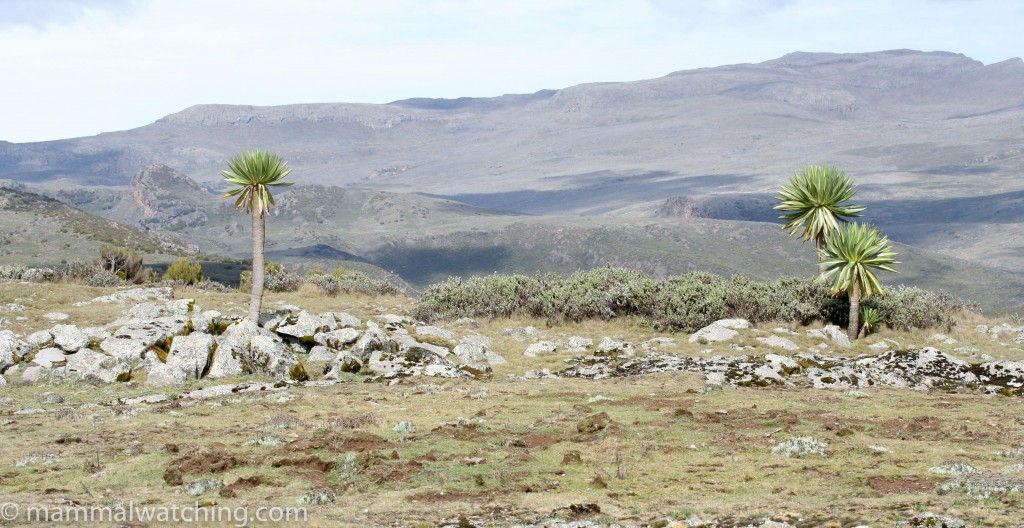
The Sanetti Plateau: last stronghold of the Ethiopian Wolf
Ethiopia is spectacular. The scenery is stunning, the people are among the friendliest I have ever met although they are some of the poorest. In parts of the country most people travel by donkey and cart and I felt like I’d stepped back several hundred years. And these villages were relatively accessible, so the deep south of the country, which is much harder to get to, must be amazing. There is a lot of wildlife and finding some of the nicest mammal species is like shooting fish in a barrel.
I had to travel to Addis Ababa for work in May 2007 after which I had a week to look around the place. But although I saw many of the mammals I was chasing I feel like I only scratched the surface. Definitely somewhere to return to.
Getting Around
Ethiopia is cheap. The major expense of any trip is hiring a car which can cost between $100-$200 (US) a day including fuel and driver. The cost of hotels, food and everything else is pretty much nominal. I used Kibran Tours. They were not the cheapest of the agents I contacted but they were competitive. I was impressed because they bent over backwards to be helpful and were also knowledgeable. The Landcruiser was in good condition and my driver/guide Workenhe was a nice enough guy who spoke good English and was happy to be flexible. He was also prepared – albeit reluctantly sometimes – to go night driving so long as he could rest in the afternoon and chew chat. I pushed his energy levels to breaking point but he forgave me.
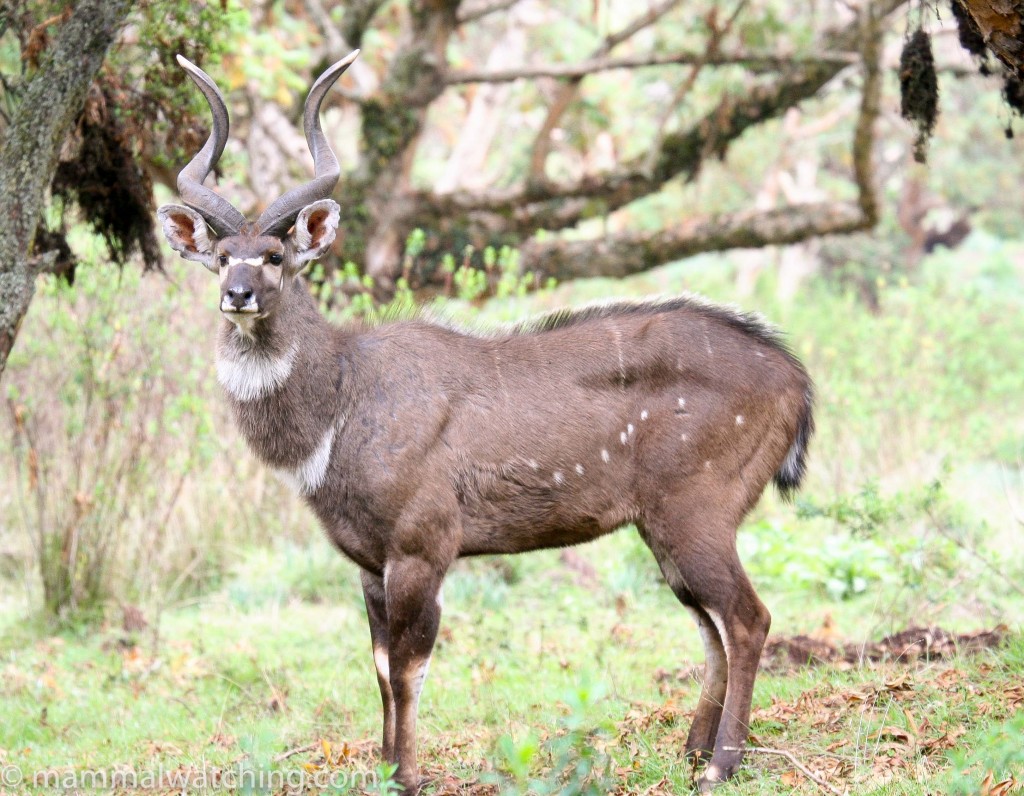
Mountain Nyala, Tragelaphus buxtoni
My trip began with a half-day trip from Addis to Debra Libanos gorge to see Gelada Baboons and back to Addis. From there I headed into the Bale Mountains for 2 nights, the most important destination for Ethiopian mammals. I traveled via Lakes Ziway and Awassa, where I spent a night. Leaving Bale I headed back to Lake Langano for the night before traveling to Awash National Park for 2 nights. With a few more days I would have added the Simien Mountains (trekking, breathtaking scenery and Walia Ibex, and indeed I visited there in 2008). With more time it sounds like Omo National Park, a remote area in the south of the country, is well worth a visit too as our several other places. Charles Foley in Tanzania gave me some useful information which helped me plan the trip.
Debra Libanos Gorge
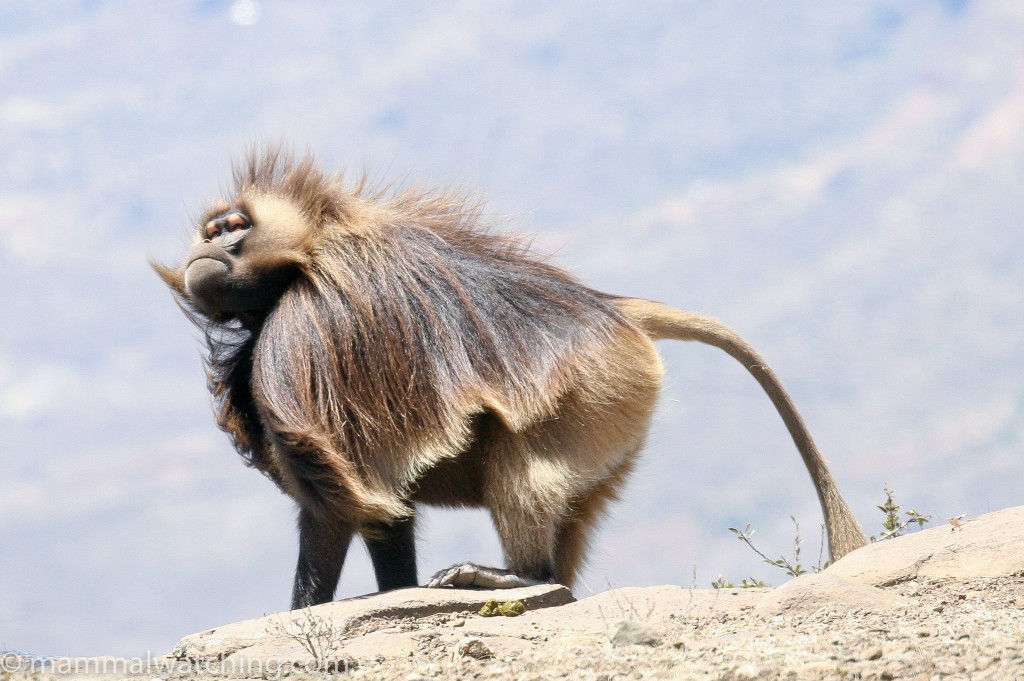
Gelada Baboon, Theropithecus gelada
Debra Libanos Gorge is a 100km – 2 hour – drive north of Addis on a good road. It takes an to escape the sprawl of Addis but thereafter the road travels across an arid plateau where a low density of livestock somehow ekes out a life. Gelada – or Bleeding Heart – Baboons are fascinating. They can live in groups of up to 600 and have the most advanced communication repertoire of any primate after people (and rather more advanced than that of Air France customer service staff).
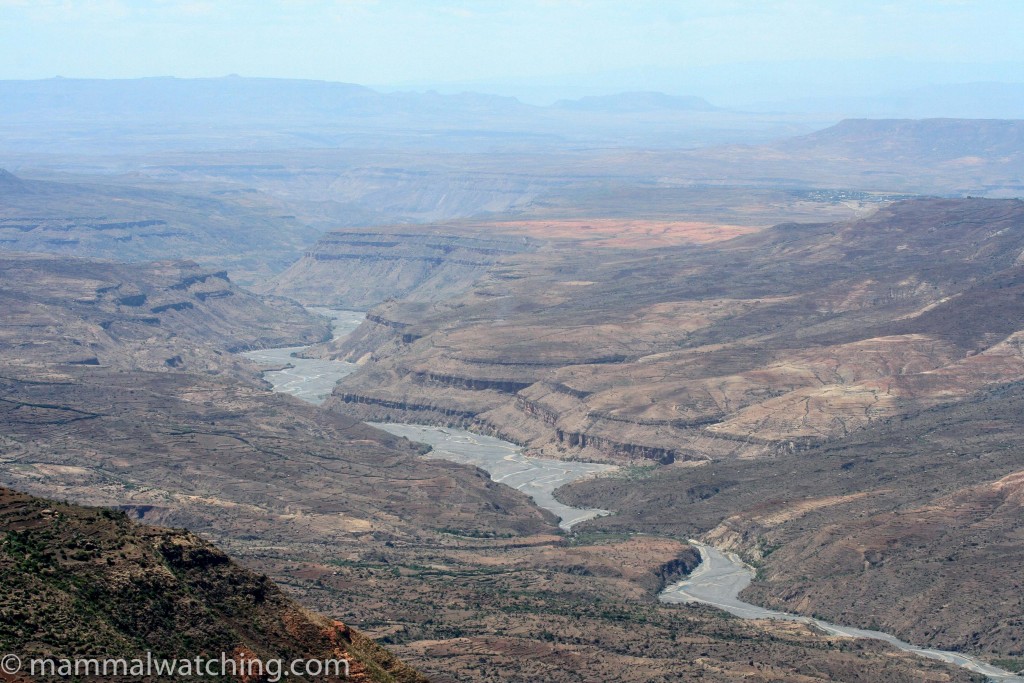
Debra Libanos Gorge
Geladas face many threats but climate change is now a particular worry. They spend the day browsing on the high grassland steppes but always near to the edge of the escarpment where they seek shelter and safety in caves. A group lives around the edge of the Debra Libanos gorge although they move around a bit.
We stopped at the lookout platform on the edge of the gorge to take a picture and spotted the Baboons about 300 metres behind us. The Geladas, like so much of Ethiopia’s wildlife, are easy to approach on foot and I got to within 20 metres of some. The males are fabulous, with their long manes blowing in the breeze as they sit picking at the grass.
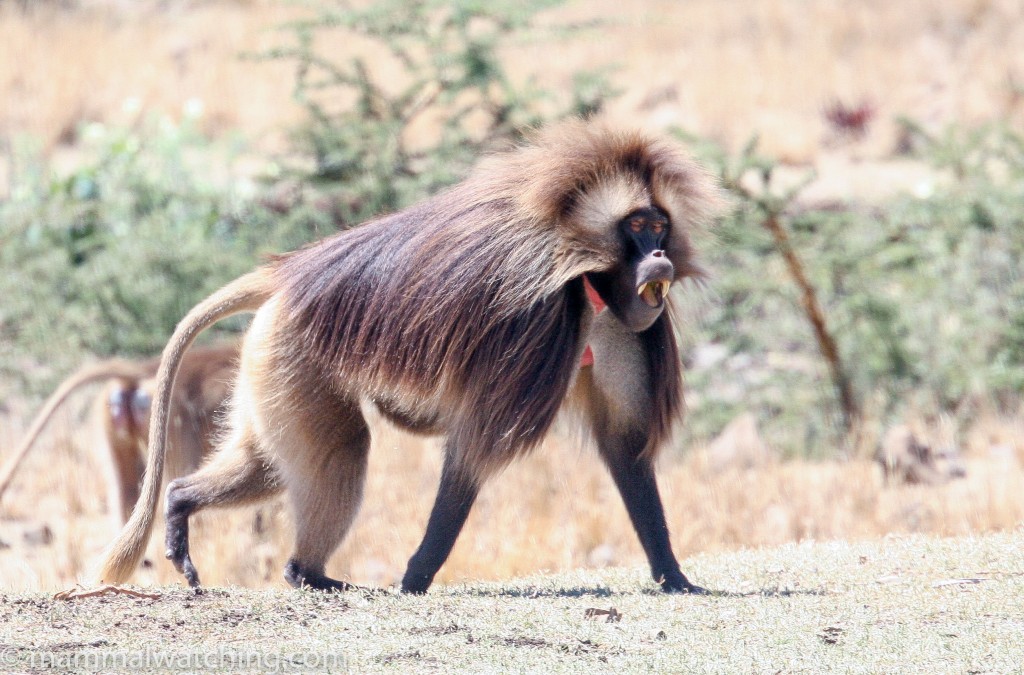
Gelada Baboon, Theropithecus gelada
Solitude is not always easy to come by in Ethiopia. As soon as we stopped the car the usual crowd of people – mainly kids – arrived, selling carvings, chewing gum and tissues. One guy appointed himself our guide. There are several caves in the area and he offered to show me one that was home to some bats. It was a couple of kilometres drive down the escarpment from the lookout point followed by a 30 minute scramble down the cliffs.
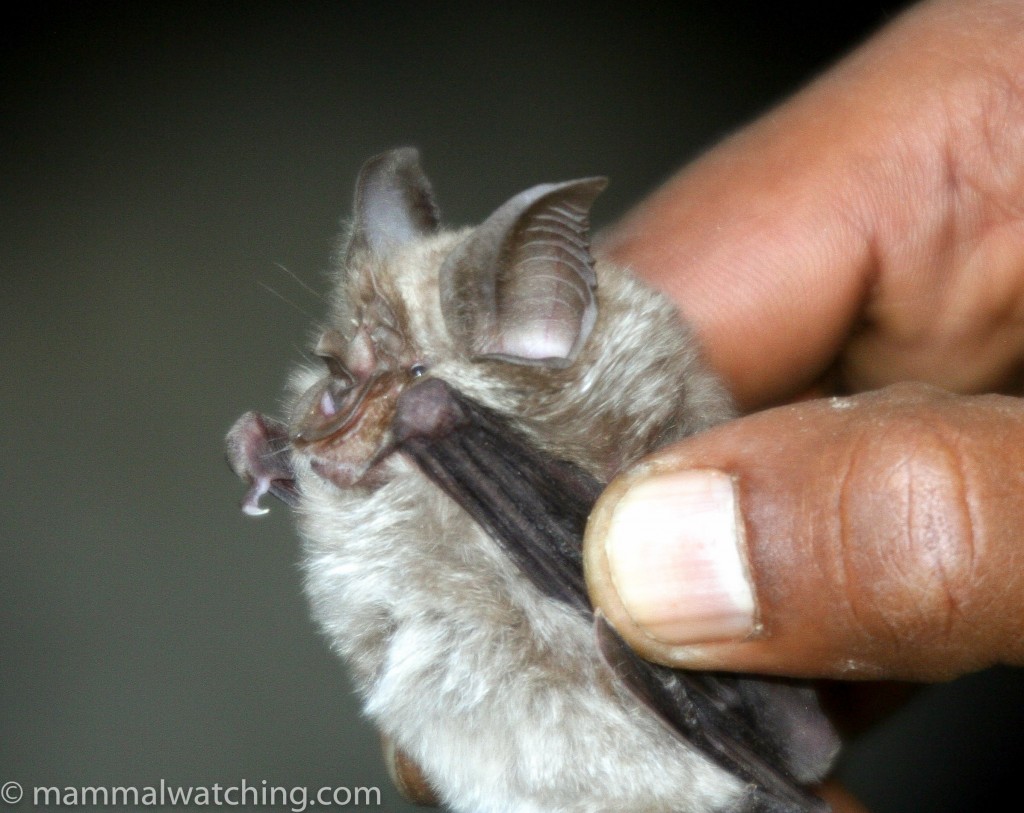
Bushveld Horseshoe Bat, Rhinolophus simulator
He said I was the first faranji to visit: I guess clambering through the scrub to spend time walking through dry bat shit isn’t top of the tourist program. There were a few Olive Baboons on the way.
The cave itself was easy to get into and was partly fortified because it had been a hideout for Ethiopian soldiers during the war against Italy in the 1930s. There was a thick carpet of guano in the cave, but – given the amount of shit – surprisingly few bats. Perhaps more use it at night. The ceiling was low and the bats were sluggish and so easy to catch.
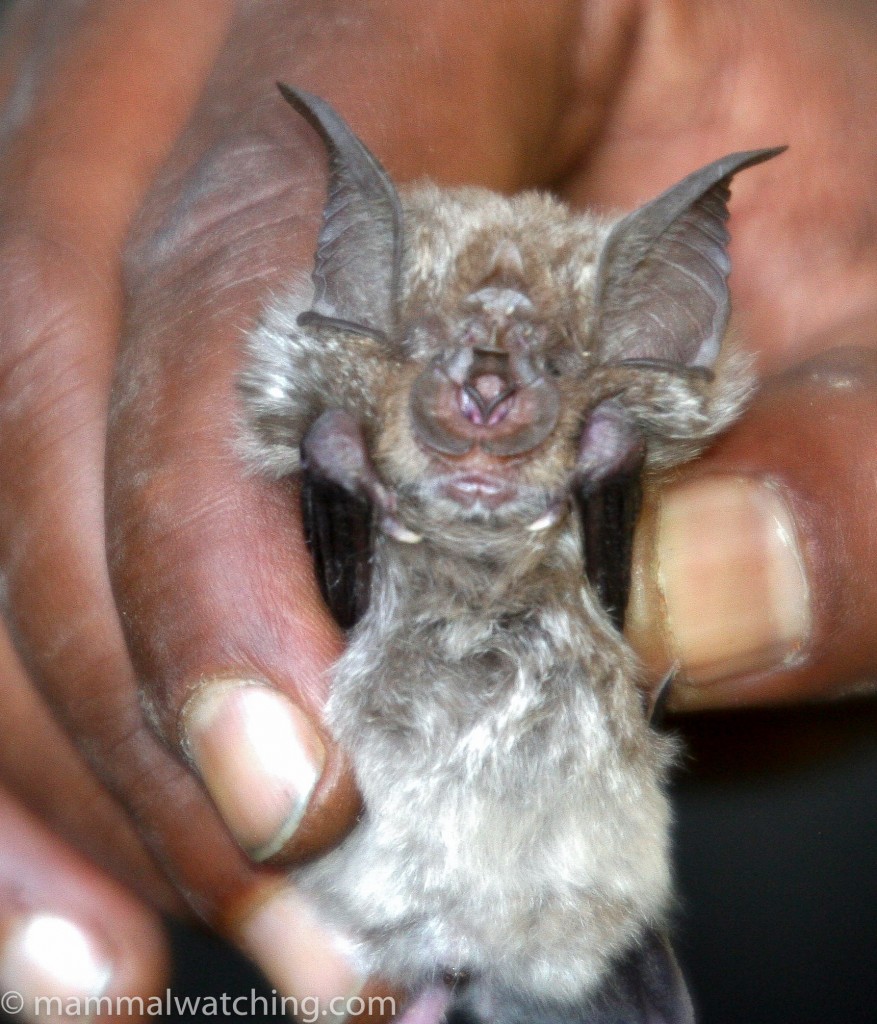
Bushveld Horseshoe Bat, Rhinolophus simulator
I found two species. Some Greater Bentwings (Miniopterus inflatus) and what I decided must have been a few Bushveld Horseshoes (Rhinolophus simulator), which I identified on the basis of size and noseleaf shape though I wish I knew someone who knew more than me about the local bats.
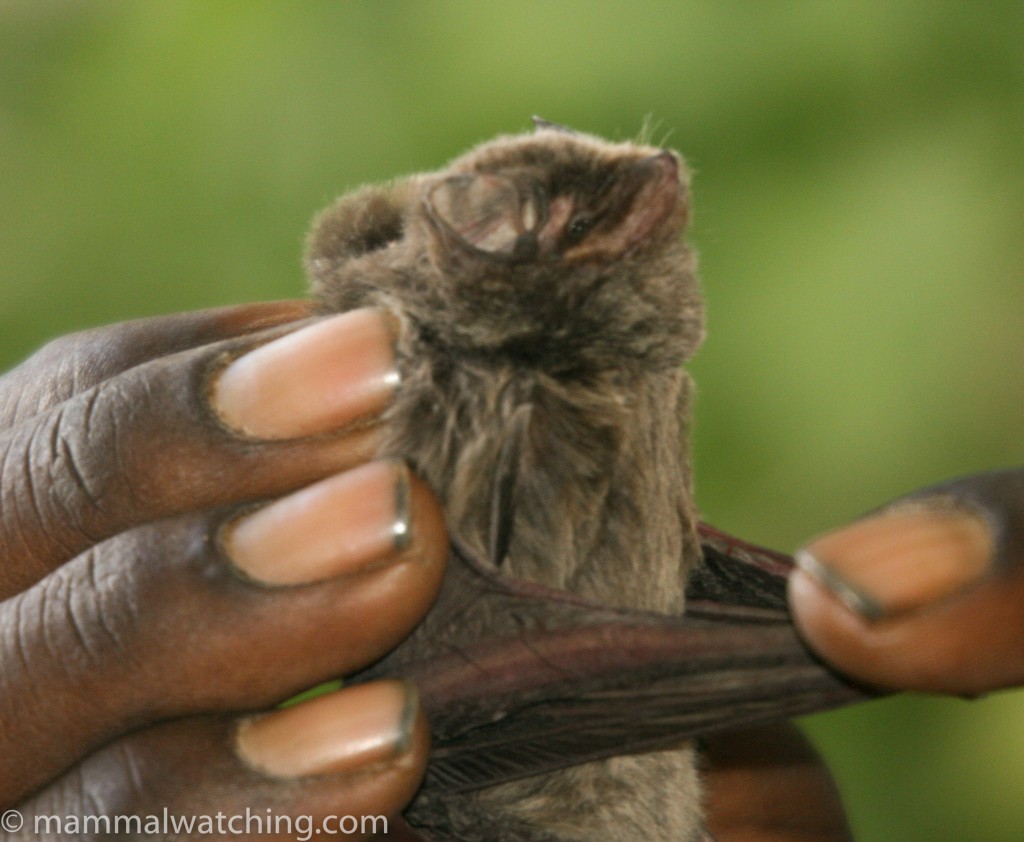
Greater Bentwing, Miniopterus inflatus
Lakes Ziway and Awassa, and the Abiata-Shala National Park
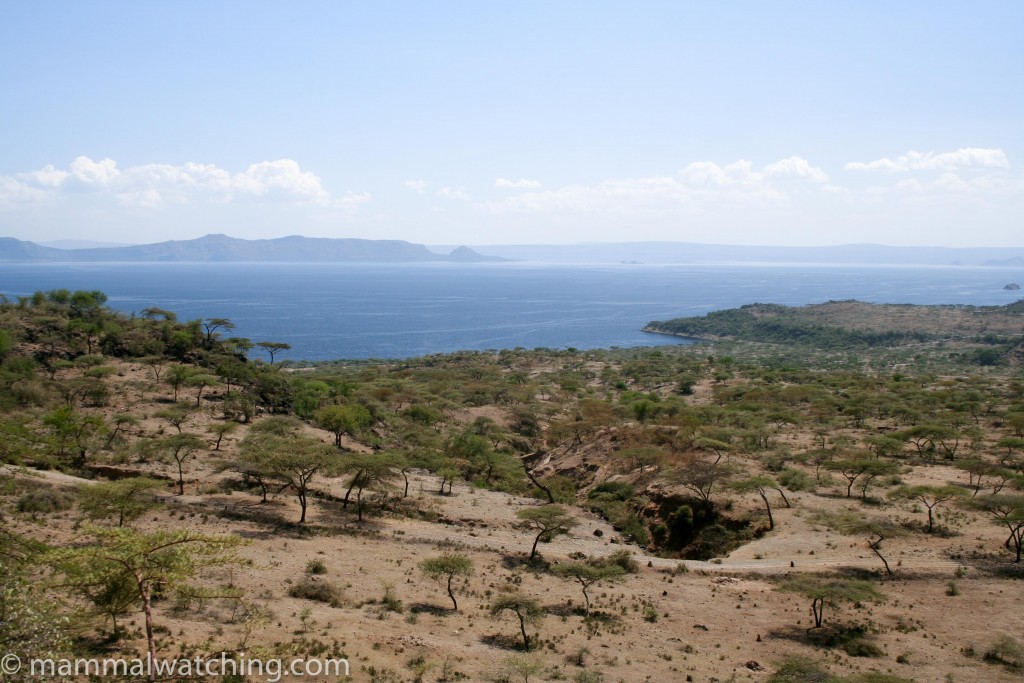
The Bale Mountains are a two day drive from Addis so we spent the day driving to Lake Awassa (about 6 hours and approximately half way). I guess it would be possible to make it in one long day but the second half of the journey was along a pretty rugged road and, besides, there were mammals to be seen en-route. About an hour out of Addis, in the middle of the town of Debre Zeyit, I was surprised to see a freshly-flattened Spotted Hyena, no doubt taken out by a truck the night before.
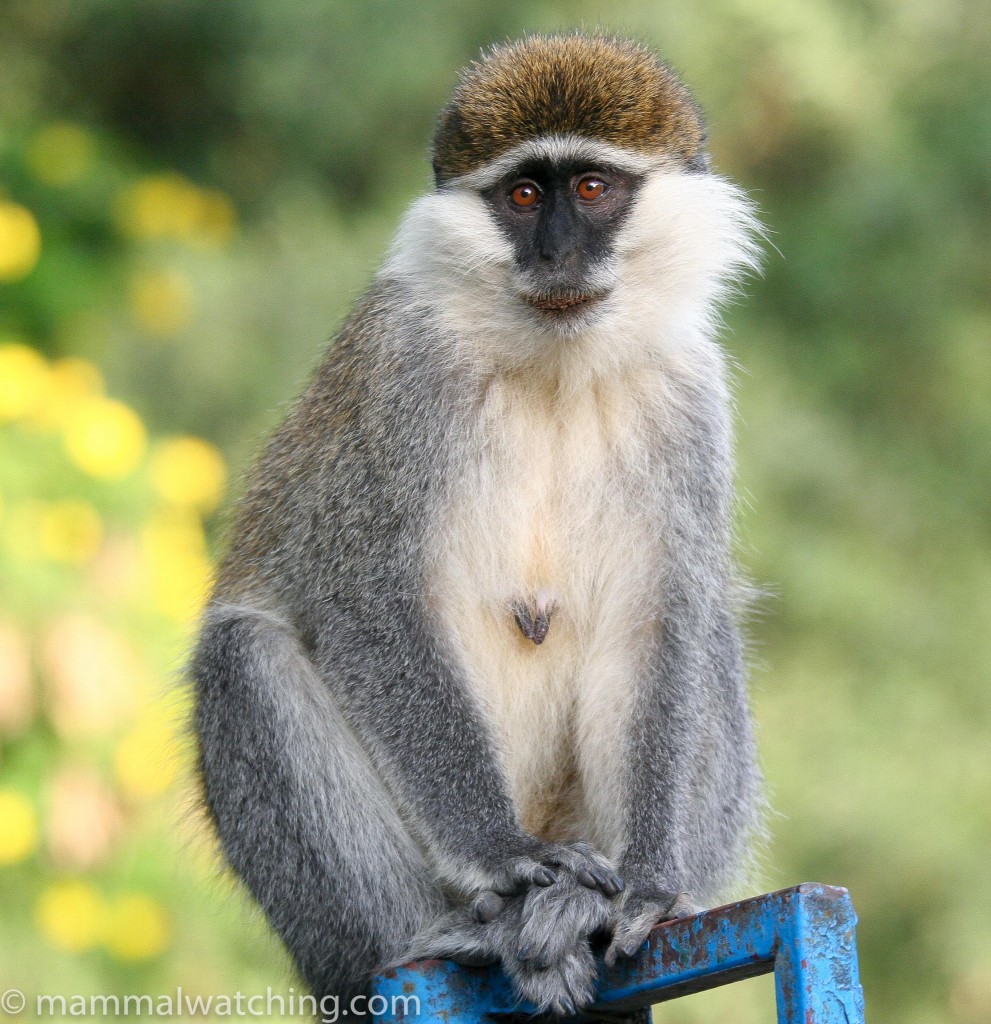
Grivet Monkey, Chlorocebus aethiops
According to NatureTrek’s Ethiopian brochure (NatureTrek are a British-based ecotour company), Tree Hyraxes are findable at Lake Ziway. There are no Tree Hyraxes in Ethiopia so I figured they meant Bush Hyraxes, Heterohyrax brucei, aka the Yellow-spotted Hyrax).
No one at Kibran Tours had seen them there and when we arrived at the lake shore in the late morning most locals denied all knowledge of the animals although a couple thought there was a slight chance you might find one in the forest if you looked very early in the morning (but to get to the forest would require an hour’s boat trip). They did however point out a Hippo.
Undaunted I thought I’d take a walk near the lakeshore anyway so Workenhe took me to a small private recreation area which we had to pay to enter. The small park had a café and a bus load of students from Addis. We asked someone whether he knew where we could see Hyraxes and he said he could show us for 50 bir (sale or return). We agreed.
He walked 10 metres and pointed to the tin roof of the café. The man has a future on Wall Street! Three animals were peeking out from the roof space. Two were Bush Hyraxes and the third, although almost identically coloured, was much larger than the others and seemed to have a different face, though I guess it was just a big Bush Hyrax.
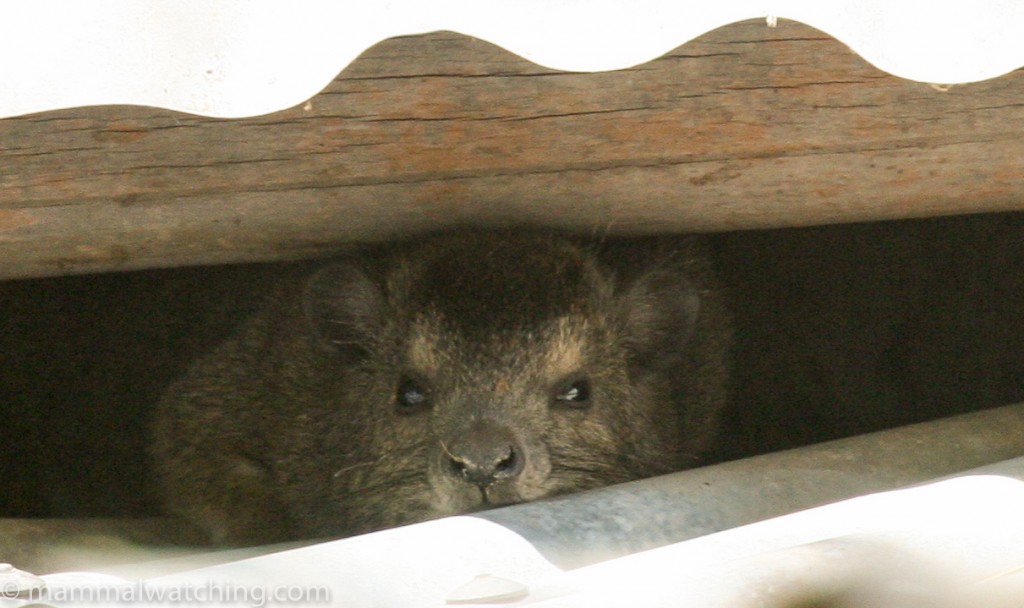
Bush – or Yellow-spotted – Hyrax, Heterohyrax brucei
There were many birds at the lake shore.
Lake Abiata-Shala National Park was another hour and a half south. The park was overrun with cattle, goats and farmers, but the lake was pretty enough and there were plenty of birds plus a Slender Mongoose that bounded across the road about half way between the gate and the lake.
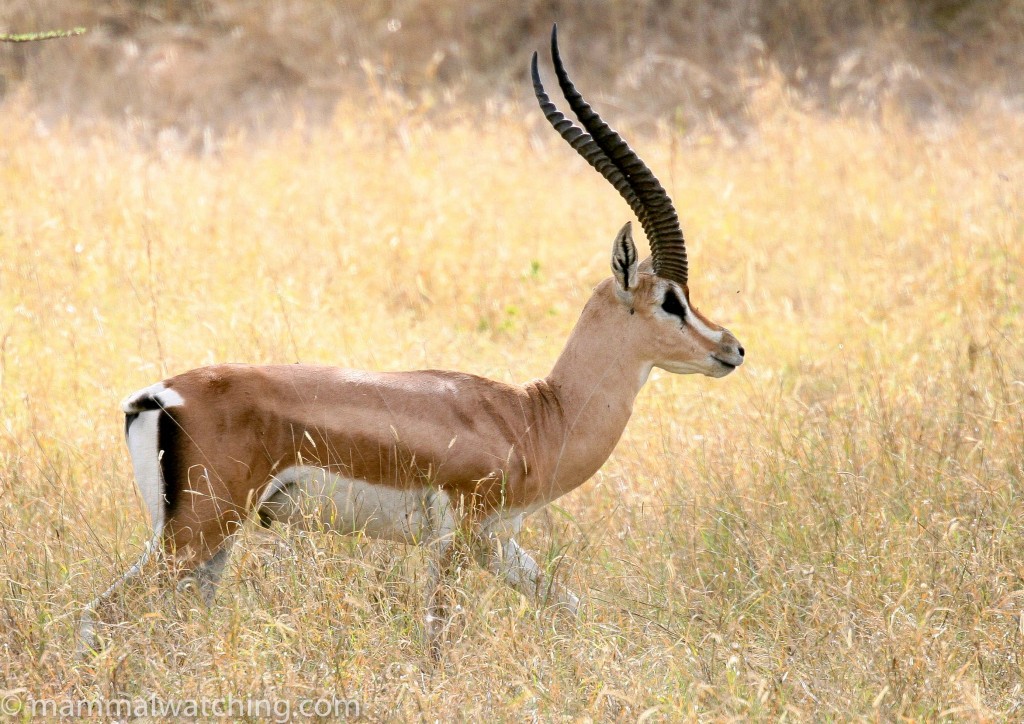
Bright’s Gazelle, Nanger notatus
I’d come here to see a Grant’s (now Bright’s) Gazelle. According to Workenhe the only bit of the park that was home to any mammals was the first kilometre or so from the entrance gate where there was still a good cover of vegetation. We spotted a pair of Oribi here but nothing else (it was mid-afternoon). One of the game scouts at the gate suggested we drive back for a few hundred metres and take a left turn past the back of the accommodation block and check out the dry creek bed. Sure enough we flushed a Gazelle that was sheltering in the creek bed. A few minutes later a herd of Gazelle appeared which were very approachable.
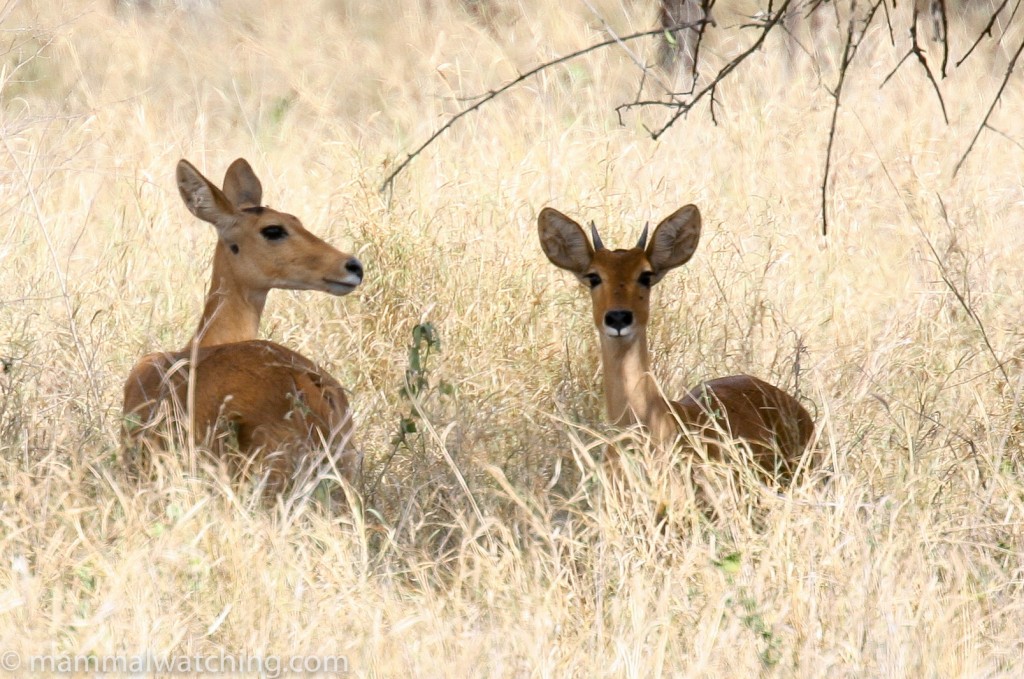
Oribi, Ourebia ourebi
It was another hour or so’s drive to Lake Awassa. Two recently privatised government hotels are right on the lake shore (the Wabe Shebele Hotels 1 and 2). We visited both and spent the night at No. 2. The place was pretty basic but the grounds and view were lovely, as were the troops of Guereza Colobus Monkeys and Vervet Monkeys that I was tripping over in both places.
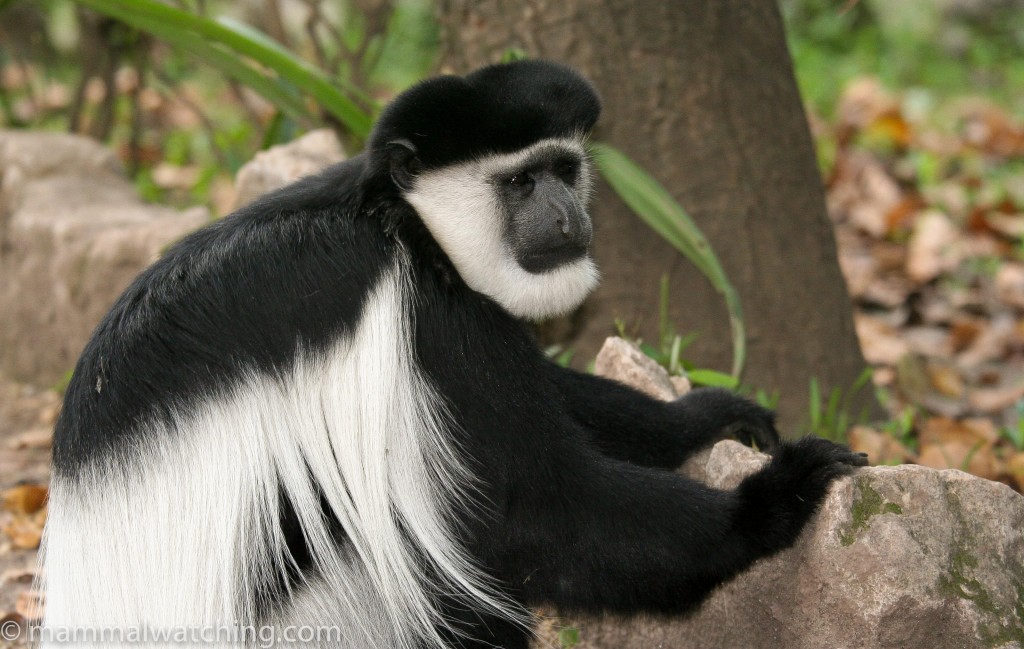
Guereza Colobus, Colobus guereza
Dinner was amusingly African. I’d been sick as a dog for a couple of days after eating a raw steak that I regretted as soon as I saw the fly covered carcass it had been sliced off of. But my appetite was returning and so I ordered onion soup, which I thought I might possibly stomach.
The waiter arrived with something white and gelatinous that looked like a bowl of porridge and did not taste of onion. I could hazard a guess that there was some chicken involved somewhere. “Is this onion soup?” I asked. … silence… “Moment”. He returned with a saucer full of fried onions which he sprinkled on top. “There you are sir”. We compromised on tomato soup instead.
Spotlighting that night I saw many small fruit bats feeding in a fruiting fig tree near the bar (at least one species of Epauletted Fruit Bat). I set a few Elliot traps in the long grass behind my room and caught a very aggressive and extraordinarily loud White-toothed Shrew species (its chinking call was of cicada-like volume so might possibly be a way to ID it.. anyone?).
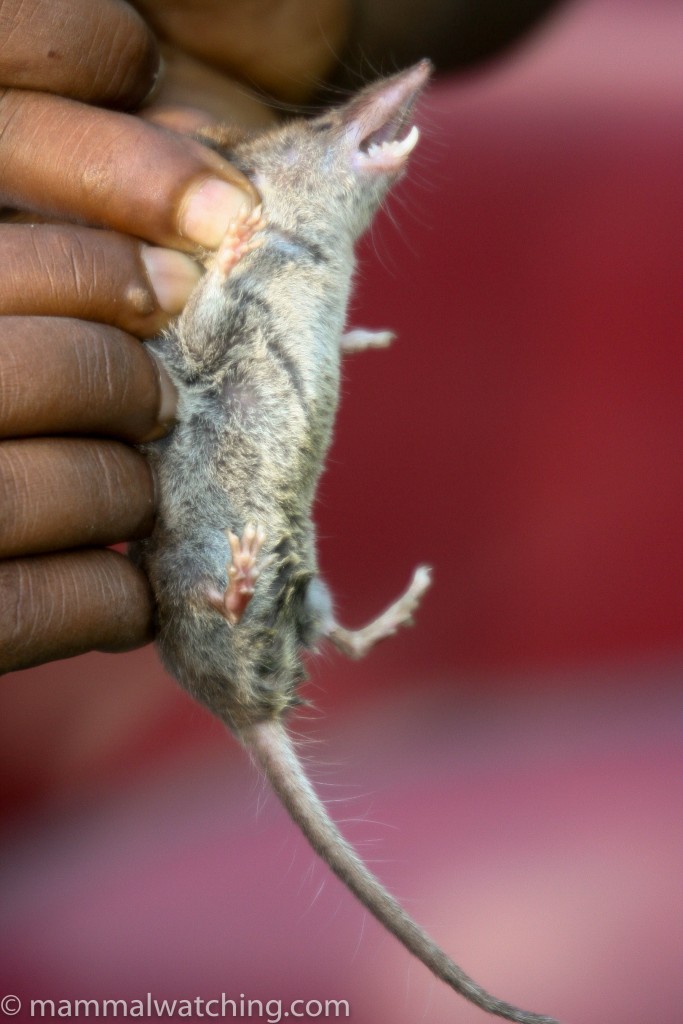
White-toothed Shrew species
If by some chance you miss the Colobus or Vervet Monkeys at the hotel then head for the Fish Market the next morning where you will see more along with about 100 Marabou Storks and many other birds.
The Bale Mountains
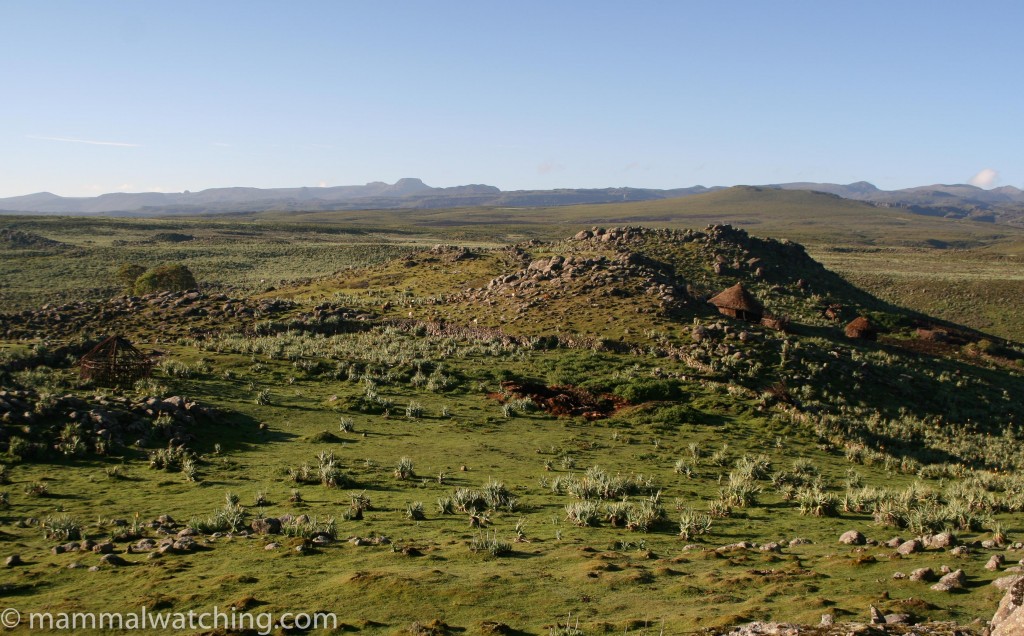
Dinsho area
It was a bone-shaking 5 hour drive to Dinsho. HQ of the Bale Mountains National Park . The scenery was speccy, particularly the last hour as you climb up through forests overlooking valleys (there were a few Olive Baboons loitering in the road during the last part of the climb through the forest). About 5km before Dinsho you come to the swampy Gaysay Grasslands, the first section of the National Park.
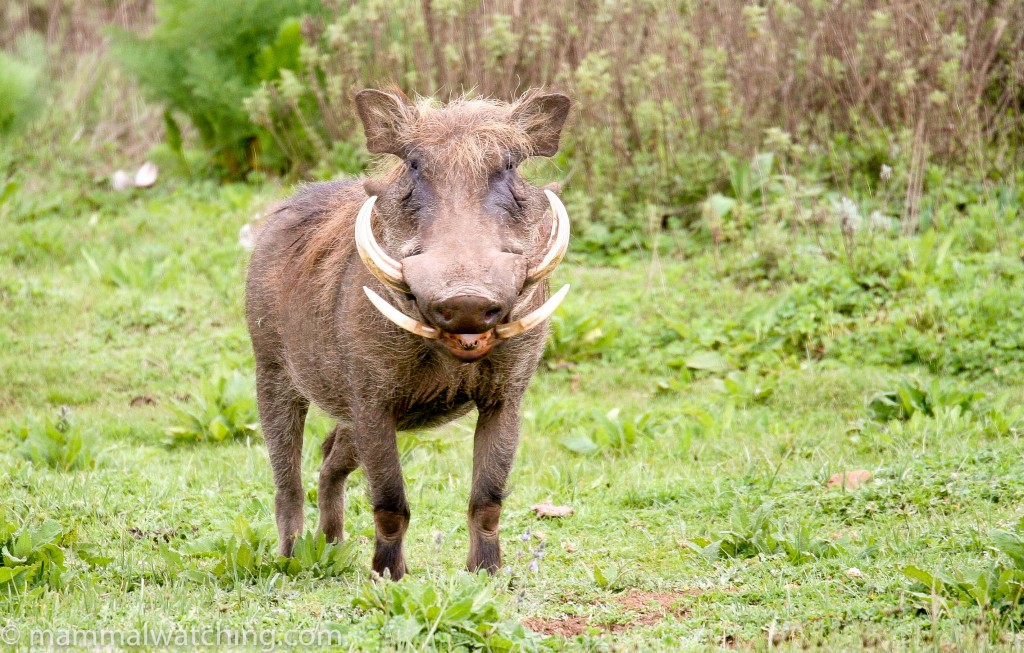
Warthog, Phacochoerus africanus
Hundreds of Warthogs were trotting around, along with several herds of the beautiful endemic and highly endangered Mountain Nyala. A few Bohor Reedbucks and Menelik’s Bushbucks (an endemic race) and some Olive Baboons kept them company.
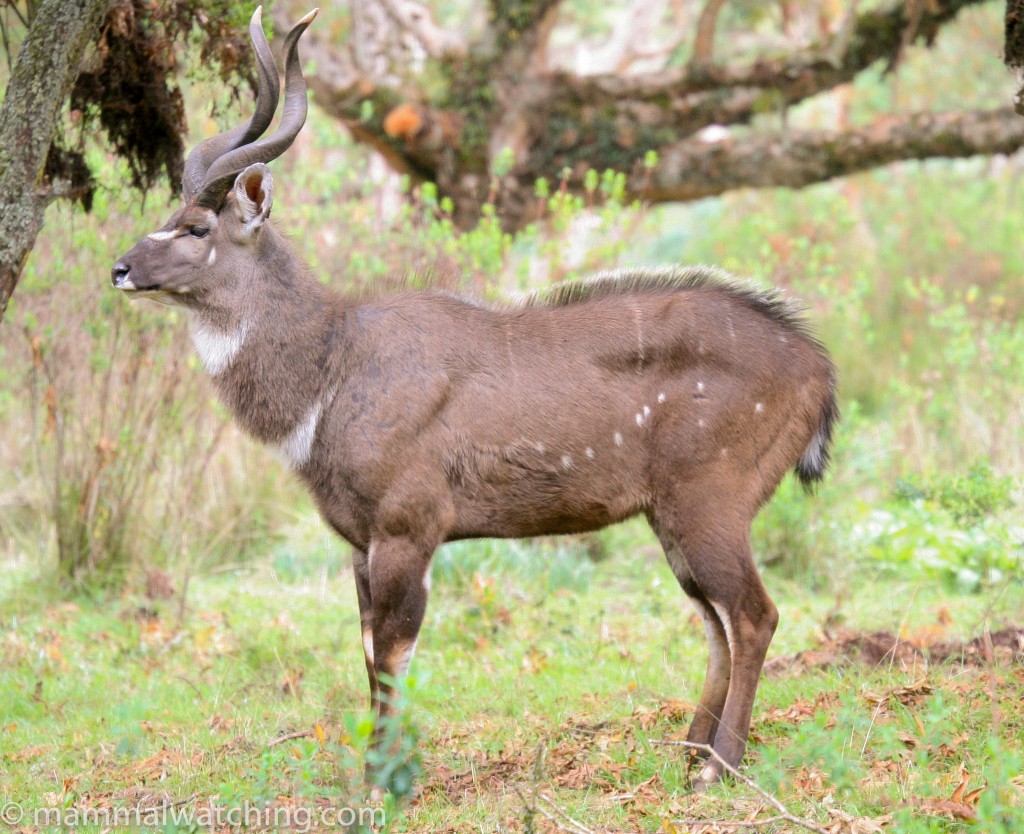
Mountain Nyala, Tragelaphus buxtoni
About 500 metres from the road I saw something catlike wandering through the antelope and took a walk over. The animal froze in some heath and I was able to get to within 30 metres or so of a Serval (not apparently such a common sighting in the middle of the day though they were common at night, and I saw another two while I was spotlighting here the following evening).
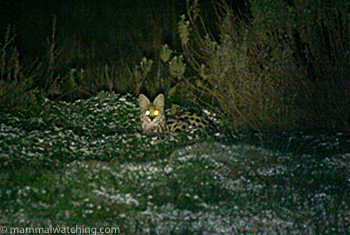
Serval, Felis serval
After lunch at the park HQ I took a walk for an hour through the forest. Many more Warthogs, Nyala and Bushbuck here along with a Golden Wolf.
I had a rather confused discussion about other mammals of the area with the people at the lodge – Porcupine and Aardvark are seen at night occasionally they said (I think), while I had to travel to the Sanetti Plateau to see Rock Hyraxes (though after my walk I was told by another guide that they lived just a short walk away). I was later told by someone who seemed more knowledgeable that Giant Forest Hogs were quite common seen in the Harrena Forest, especially around cultivated land, while Bale Monkeys were rare and shy but there was a good spot for them there. I didn’t get precise directions but you could try talking to Kemal in Dinsho when you get there for more info (or read more recent reports as others now find them regularly).
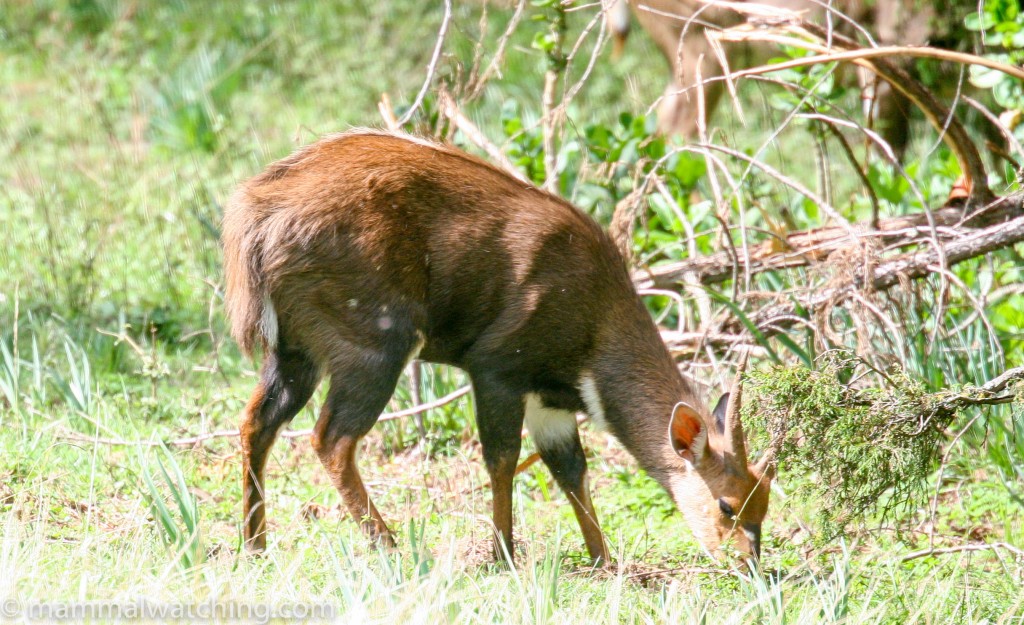
Menelik’s Bushbuck, Tragelaphus sylvaticus meneliki
We spent the night at the Wabe Shebele hotel in Goba.
It’s an hour’s drive from Goba to the start of Sanetti Plateau. We left at 8am, though on reflection it would have been good to have left a couple of hours earlier.
The plateau is untouched and extraordinary. The first stretch road passed through heathland with a thick cover of vegetation. Although there were many rodent burrows they were all fairly waterlogged which perhaps explains why we didn’t see any rats. I took a scramble over some rocks about 1km before the first telecom station and flushed a pair of endemic Starck’s Hares and a pair of Klipspringers.
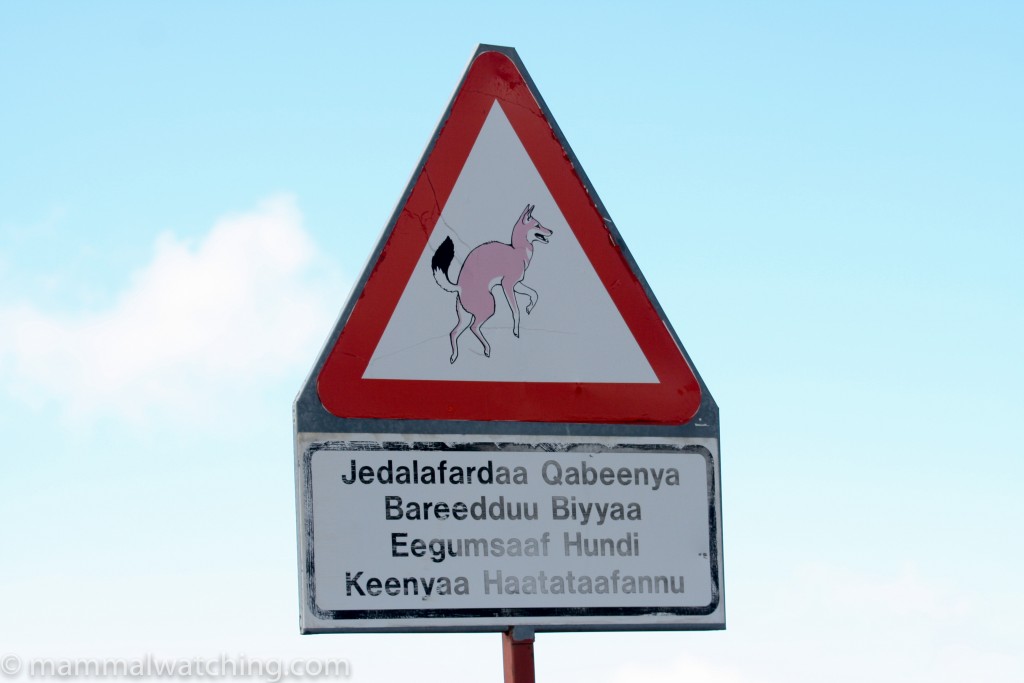
It wasn’t until just after the telecom station (and the Ethiopian Wolf crossing roadsign) that I began to see the first rodents.
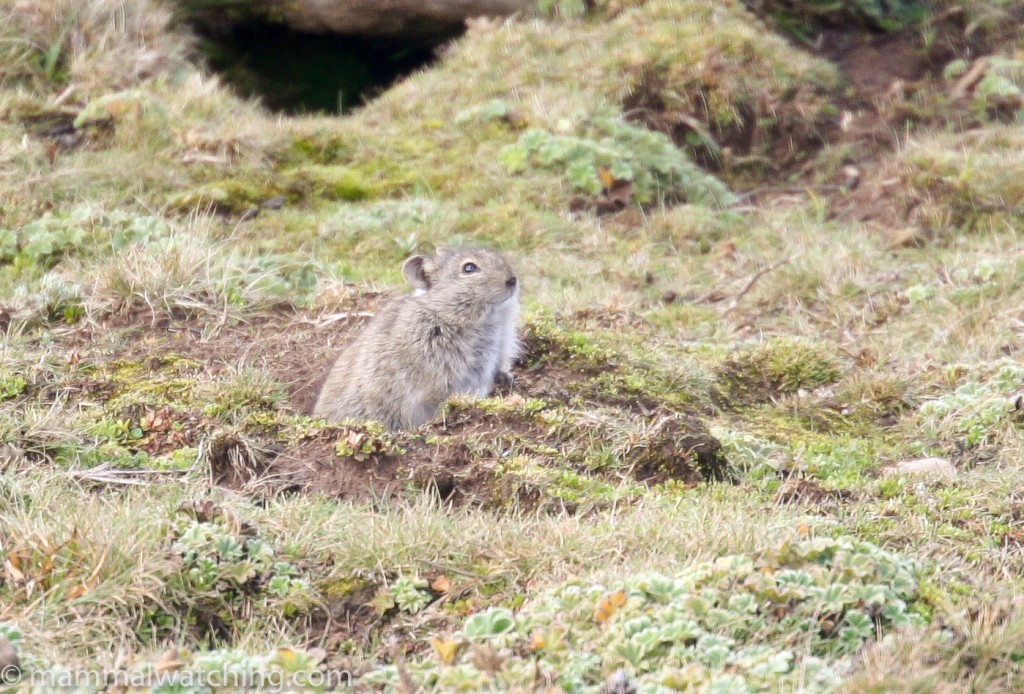
Blick’s Grass Mouse, Arvicanthis blicki
But they were everywhere and so far as I could tell comprised two species mainly Blick’s Grass Mouse (Arvicanthis blicki_, which was pictured in the Bale Mountain Guidebook; along with fewer Black-clawed Brush-furred Rats (Lophuromys melanonyx) which have much larger ears than the Blicki.
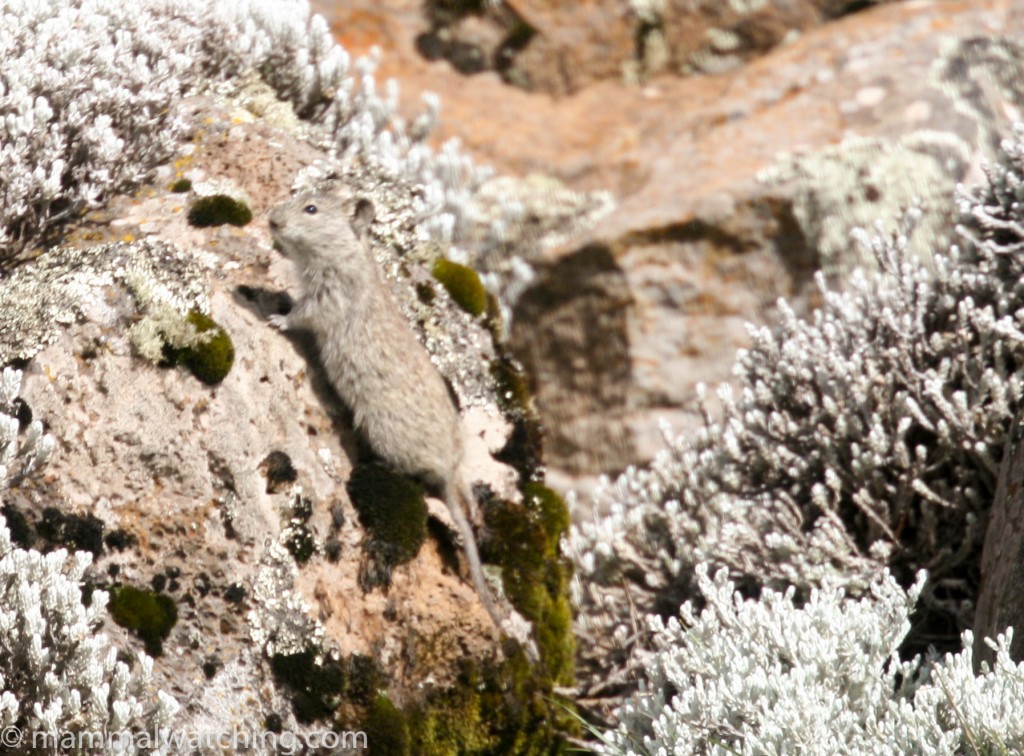
Blick’s Grass Mouse, Arvicanthis blicki
According to the trapping data at the research station, Black-clawed Brush-furred Rats were the next most abundantly caught species on the plateau. Higher up on the plateau I saw a couple of other rats which appeared to be different, perhaps Short-tailed Brush-furred Rats (Lophuromys brevicaudus), but I could not be sure.
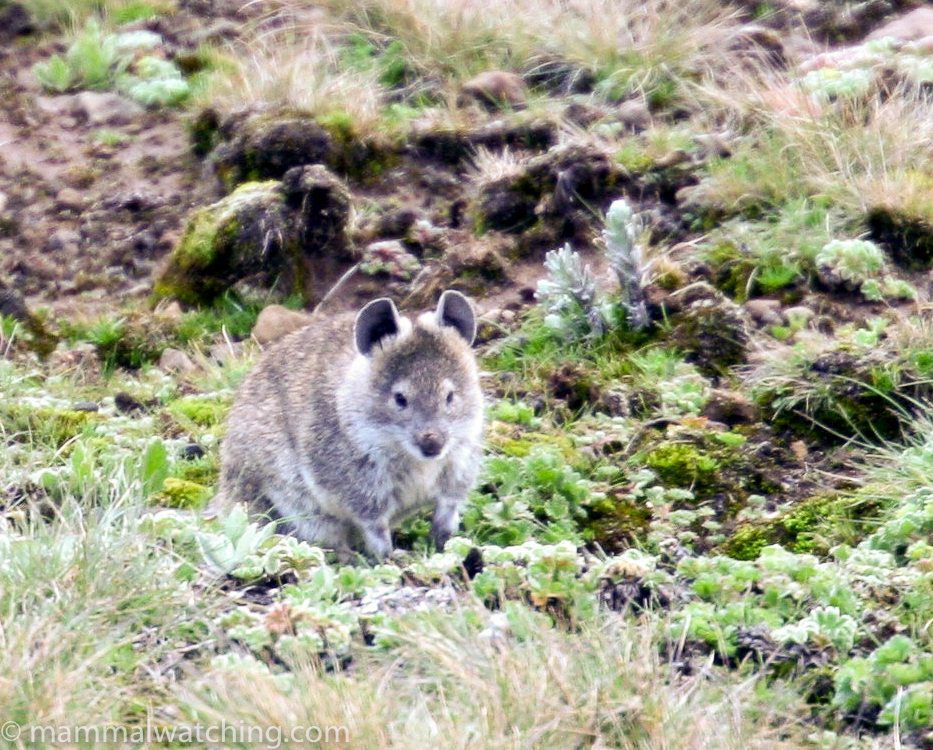
Black-clawed Brush-furred Rats, Lophuromys melanonyx
All three species are endemic. The rodents were immensely difficult to get close to – dashing for cover at the slightest noise or movement. I got better views from inside the vehicle. “Abundant” does not do the population justice. I read that the plateau has an estimated biomass of up to 4000 kg per square kilometre (roughly equating to a shit load of rats) which does not on reflection surprise me.
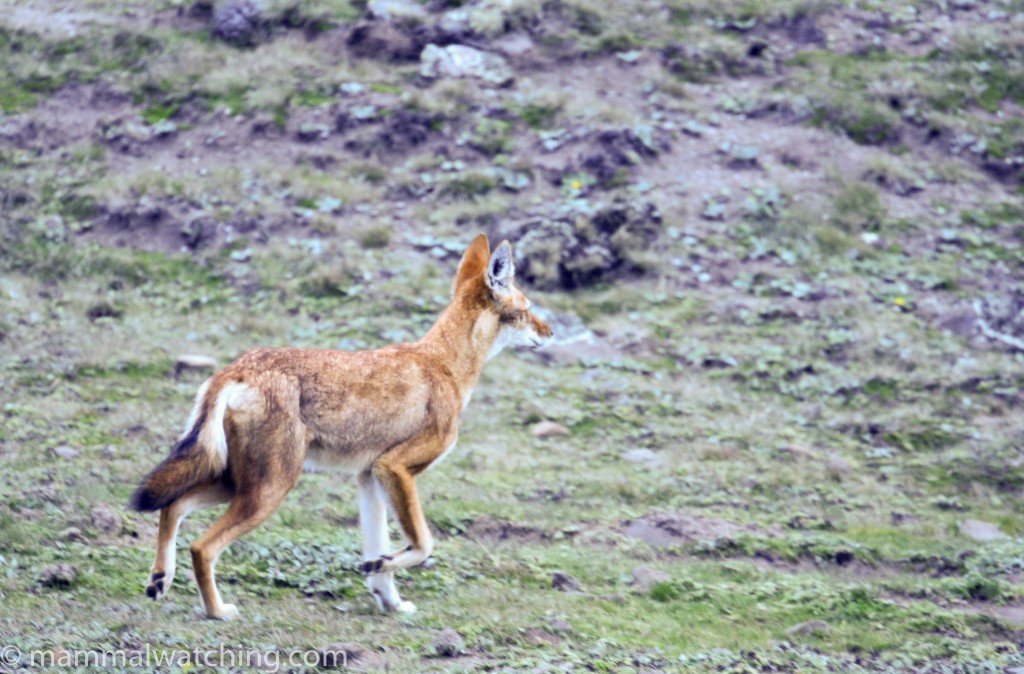
Ethiopian Wolf, Canis simensis
A couple of kms further on I saw my first Ethiopian Wolf. It was 500 metres off the road and wandering through the rocks. A second came into view and the pair disappeared from sight. Such a beautiful animal – long-legged with white socks and surprisingly rich red fur.
That just left the Giant Mole Rat (Tachyoryctes macrocephalus). Though nowhere near as common as the smaller rodents I ended up seeing about 10 over the course of 6 hours – most of the time just the golden head sticking up above ground like a glove puppet, but I also saw 2 or 3 moving above the surface. They were, if anything, even shyer than the smaller rodents and I could not get within decent range for a photo.
As you continue up the plateau you come to a second warning wolf sign and a few hundred metres further on we found a wolf resting at the side of the road. We stopped the car and I was amazed by the animal’s hearing. Though it was very windy and the dog was at least 20 metres away its ears would prick up if I rubbed my finger and thumb together lightly from inside the car with the window down. Magical.
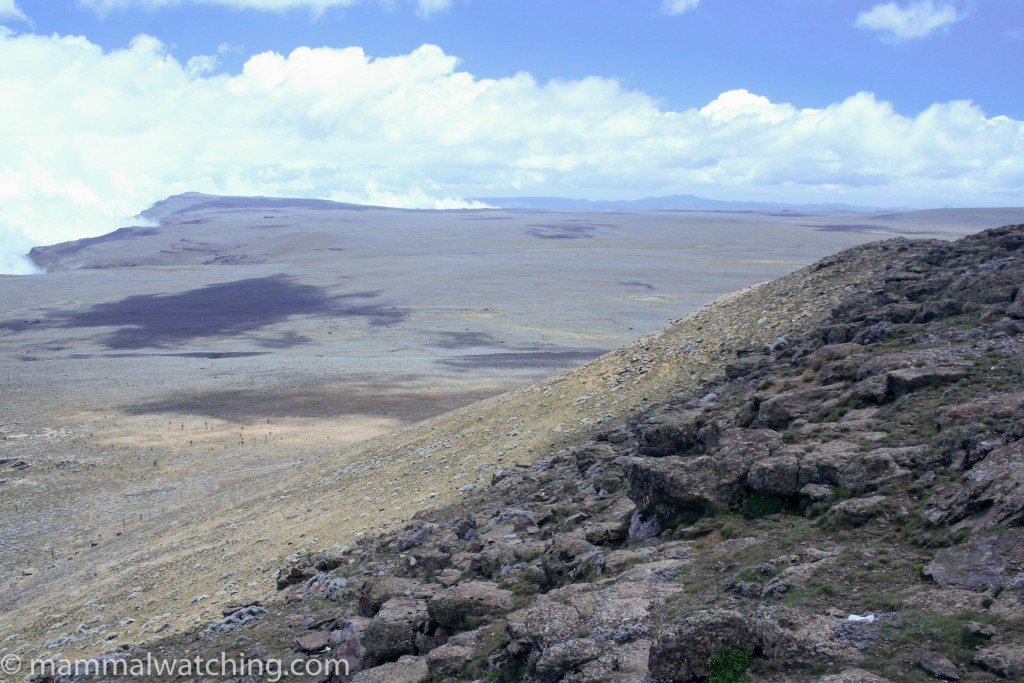
Sanetti Plateau
We continued to drive up the plateau. Not long after I had seen the wolf the rats disappeared – perhaps they vary their altitude seasonally?
If you follow the road further on it drops over the escarpment and eventually reaches the Harrena forest. The clouds had rolled in and there was no view from the escarpment edge, while the forest would have meant another 20kms of rough road, and so we decided to head back to Dinsho to spend the night at the park HQ.
Spotlighting along the road through the Gaysay Grasslands that night was excellent. There were plenty of Reedbuck, Nyala and Bushbuck along with at least 10 Common Duikers that I hadn’t seen in the daytime. We saw another 2 Servals and a handful of Warthogs. Spotted Hyenas apparently forage around the village at night but den in the grasslands, so about 6pm is a good time to see them leaving the grasslands for a night’s scavenging.
At 6am the next morning I met up with one of the scouts who’d promised to show me Rock Hyraxes.
“Korne Mountain” (or something like that) is a brisk 45 minutes walk from the Dinsho HQ. The scenery at the top of this small boulder-strewn summit was magnificent and sure enough there were at least 10 Rock Hyraxes up there, basking in the sun and grazing between the rocks. The late afternoon is also a good time to see them. The Ethiopian Rock Hyrax is sometime regarded as a separate species, but the consensus seems to be that it is a race of the Rock Hyrax found all over Africa (Procavia capensis).
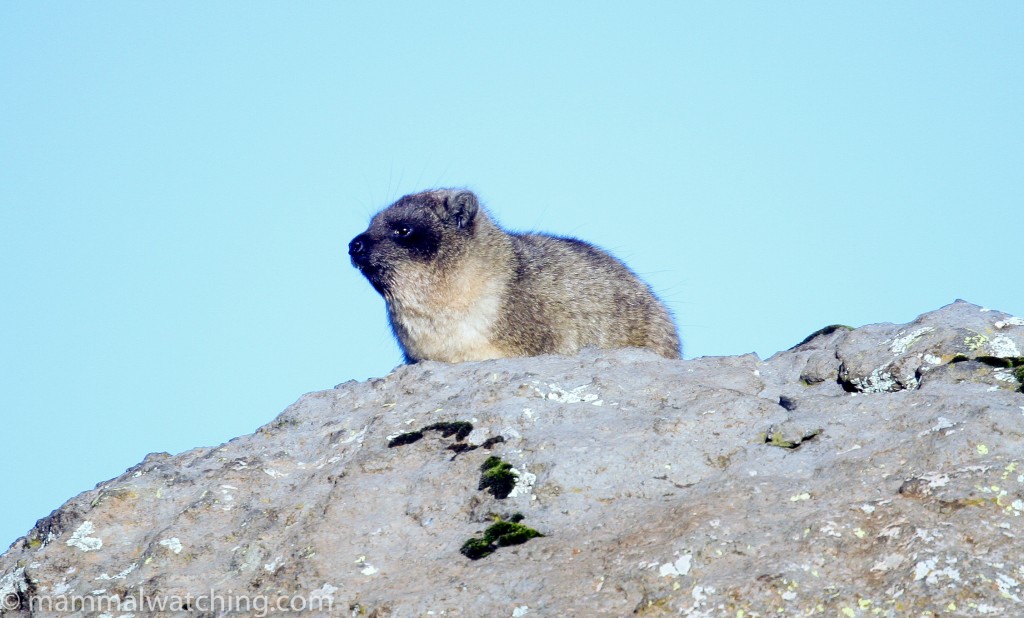
Rock Hyrax, Procavia capensis
There is a pretty good guide book/brochure to the Bale Mountains for sale at Dinsho lodge. It has some useful information about many of the larger mammals. Meanwhile the museum and lodge houses a few specimens of things that have been collected thereabouts including Aardvarks, an Ethiopian Genet, an African Civet and several smaller mammals including three rodents – Yellow-spotted Brush-furred Rat (Lophuromys flavopunctatulus), a skin labelled as Praomys albipes (I am not sure of teh Ebnglish name), and Lovat’s Climbing Mouse (Dendromus lovati), together with something labelled as a Smoky White-toothed Shrew (Crocidura fumosa) which according to IUCN is restricted to the Aberdare range in Kenya. Who knows…?
It was a bumpy 4 hours or so back to the tarmac, with a Golden Wolf and a couple of Olive Baboons en route. I took a quick detour to Senkele Wildlife Sanctuary after lunch. It wasn’t worth it unless you are keen to see the very nice looking endemic race of Swayne’s Hartebeest.
It takes about 45 minutes to get to the reserve from Shashemene and after you have driven for a kilometre or two past dozens of Hartebeest, a few Oribi and a handful of Warthogs the animals give way to people. The place is overrun by tribesmen tending their cattle and goats or collecting firewood. Apparently there is some bad blood between the locals and the federal government, the former not seeing any of the park revenue which goes to the latter, or so I was told.
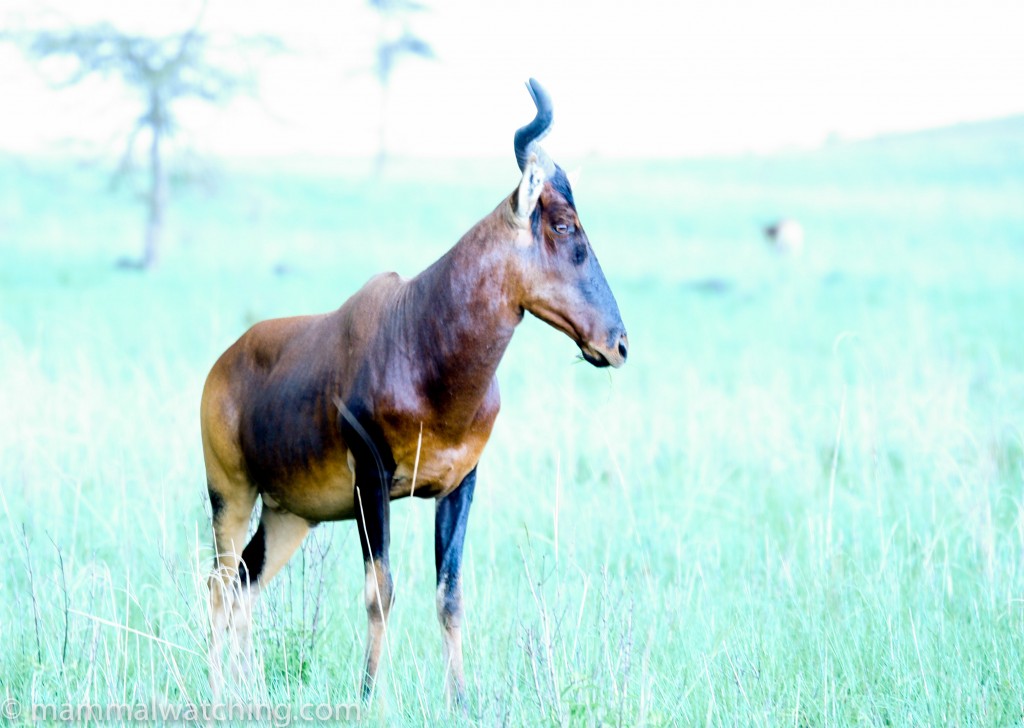
Swayne’s Hartebeest Alcelaphus buselaphus swaynei
We spent the night at the Bekele Mola hotel at Lake Langano. There are Rock Hyraxes in the cliffs beside the hotel. And my room – along it seems with most of the others – had plenty of bats living in the roof space. I threw up a net and caught three Little Free-tailed Bats (Chaerophon pumila) (identified on the basis of their small – 40mm – forearms and plain colouring).The two females were remarkably placid in the hand – the male was totally agro.
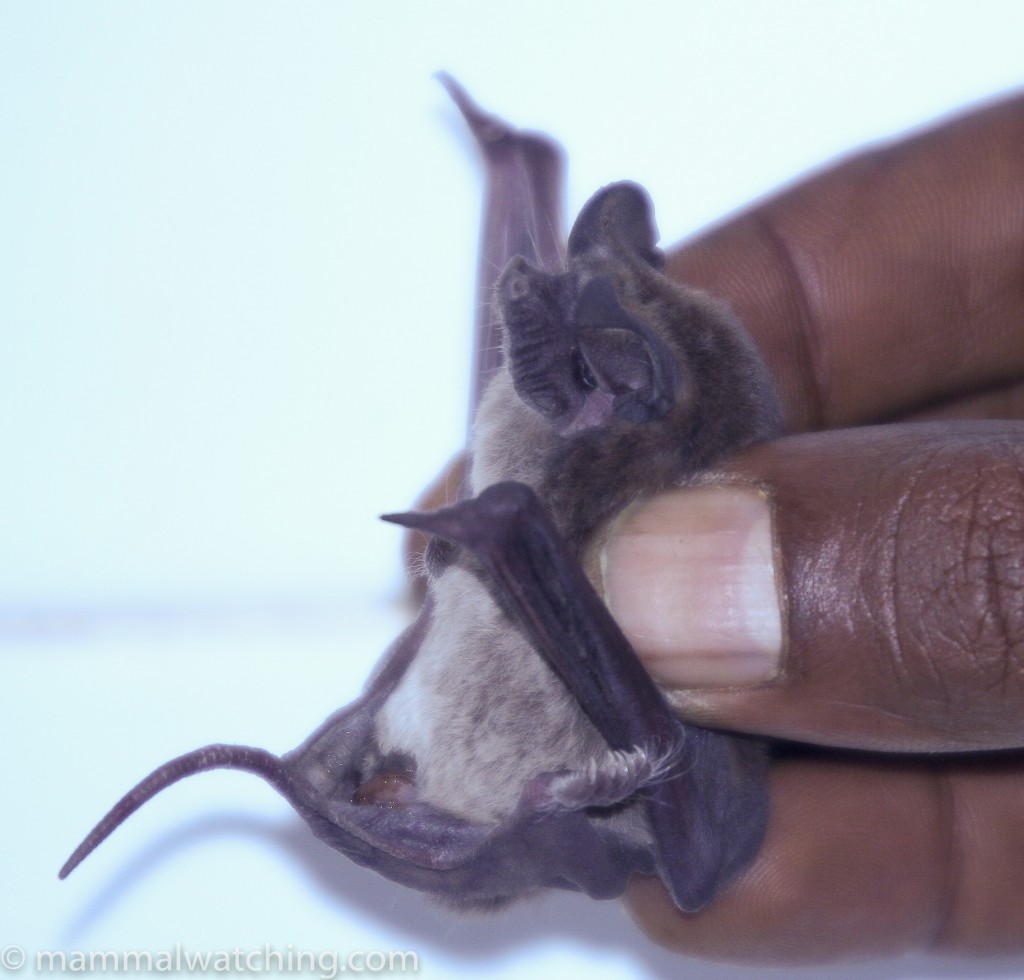
Little Free-tailed Bat Chaerephon pumila
Spotlighting that night on foot around the cliffs came up with nothing other than a night watchman who reckoned Hyenas were common around the small garbage dump and Warthogs were around too. I saw some Warthogs the next morning.
Awash National Park
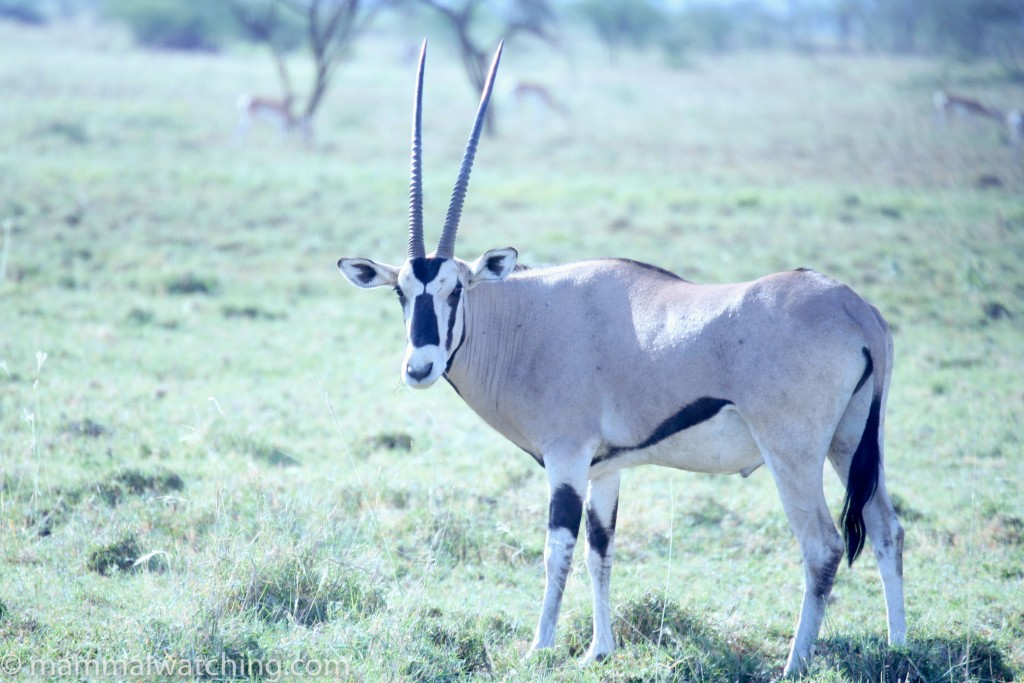
Gemsbok (Beisa Oryx), Oryx gazella
Awash is only about 4 hours from Addis (or 5 from Lake Langano). I arrived mid-afternoon. It was far hotter than the highlands.
There was considerable excitement at Park HQ because for the third day running the rangers hadn’t managed to find any food to give to the pet lion that was being kept in a chicken wire enclosure by the campsite (the lion had just arrived and there was a long and complicated story about it being confiscated from the person keeping it as a pet). It didn’t look real happy. And when it started roaring with hunger that night with just some chicken-wire and a 50 metre stroll separating it from my tent I didn’t feel real happy either.
You are required to take a scout with you wherever you go in Awash. I was assigned Hailu and he was excellent: a really nice guy who was ready to work hard and late into the night to look for things.
Awash has a number of nice mammals. Although Lions and other large predators are rare, there is a good diversity of ungulates and spotlighting there was good.
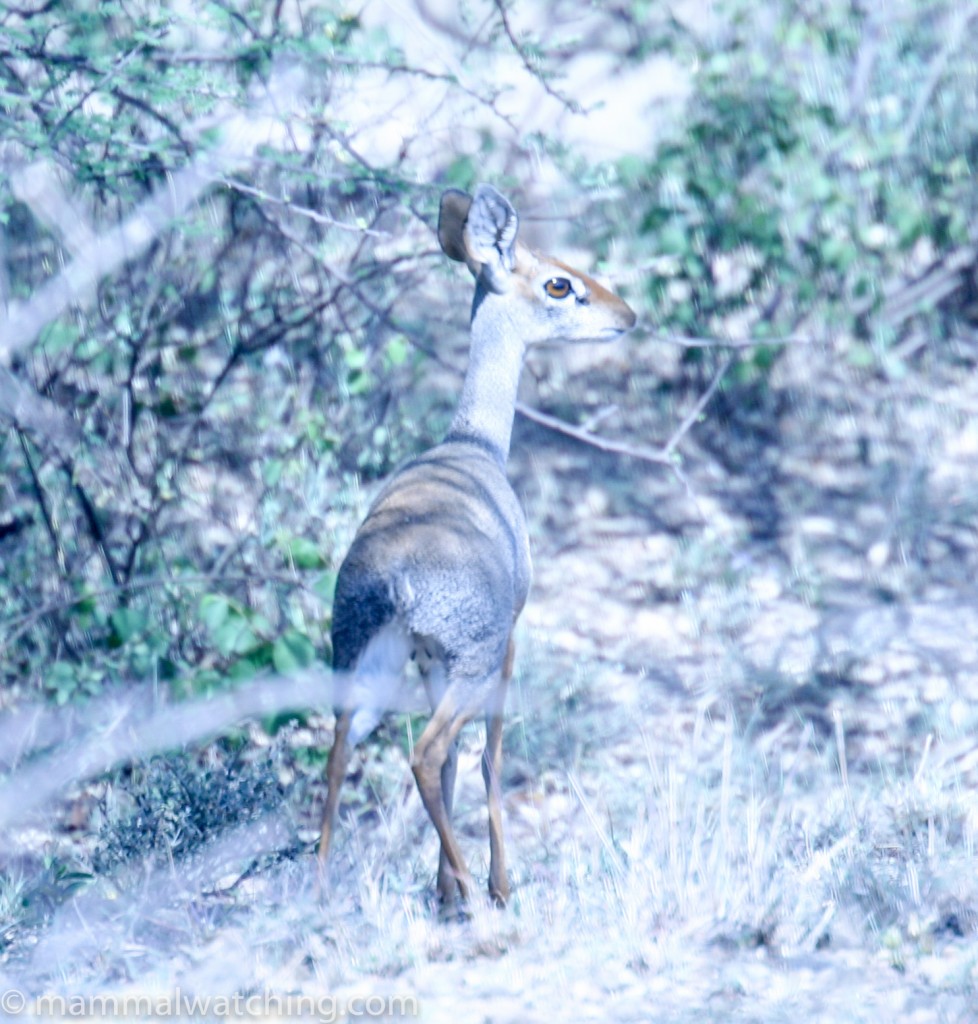
Salt’s Dik-dik, Madoqua saltiana
Salt’s Dikdiks were common. I saw my first pair in a neighbouring campsite and we saw many other pairs scattered through the acacia scrub over the next 48 hours.
Soemmerring’s Gazelles and Beisa Oryx both prefer the grasslands, and the drive between the campsite and the “lodge” (a run down trailer park with a reasonable restaurant and a spectacular view) was a good place to find them.
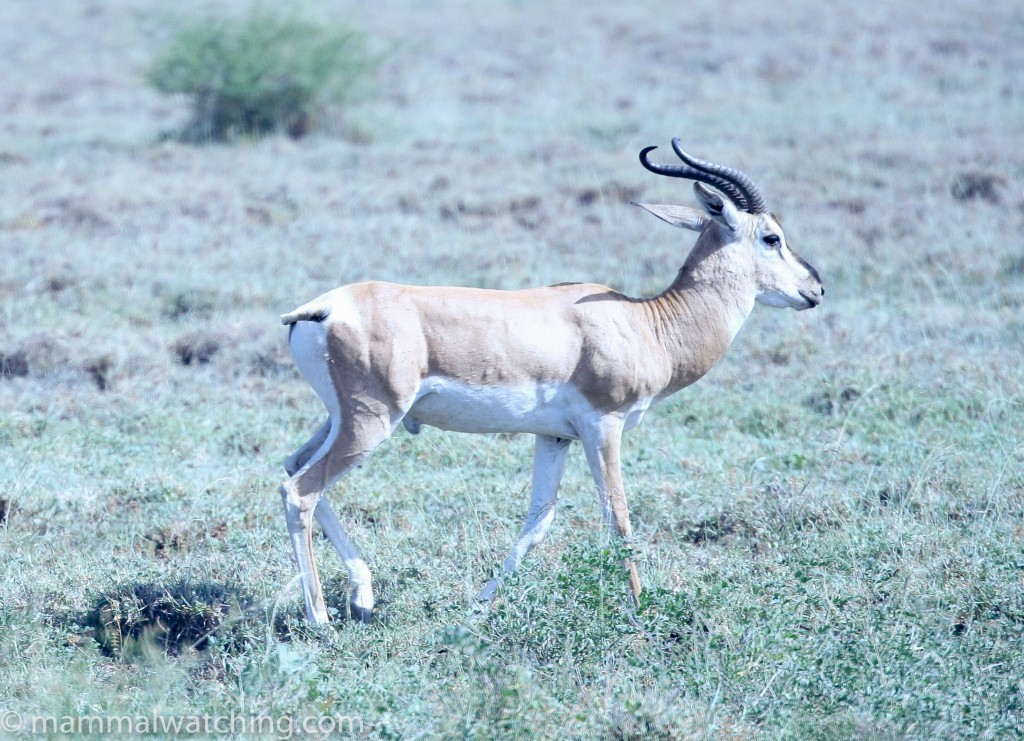
Soemmerring’s Gazelle, Gazella soemmerringii
Lesser Kudus were more difficult. We bumped into a few over the next few days, mainly in the evenings and night (but that was when we did most driving anyway). They are apparently much easier to find in the dry season when they hang around the river. May is a mini-wet season in Awash and the animals disperse.
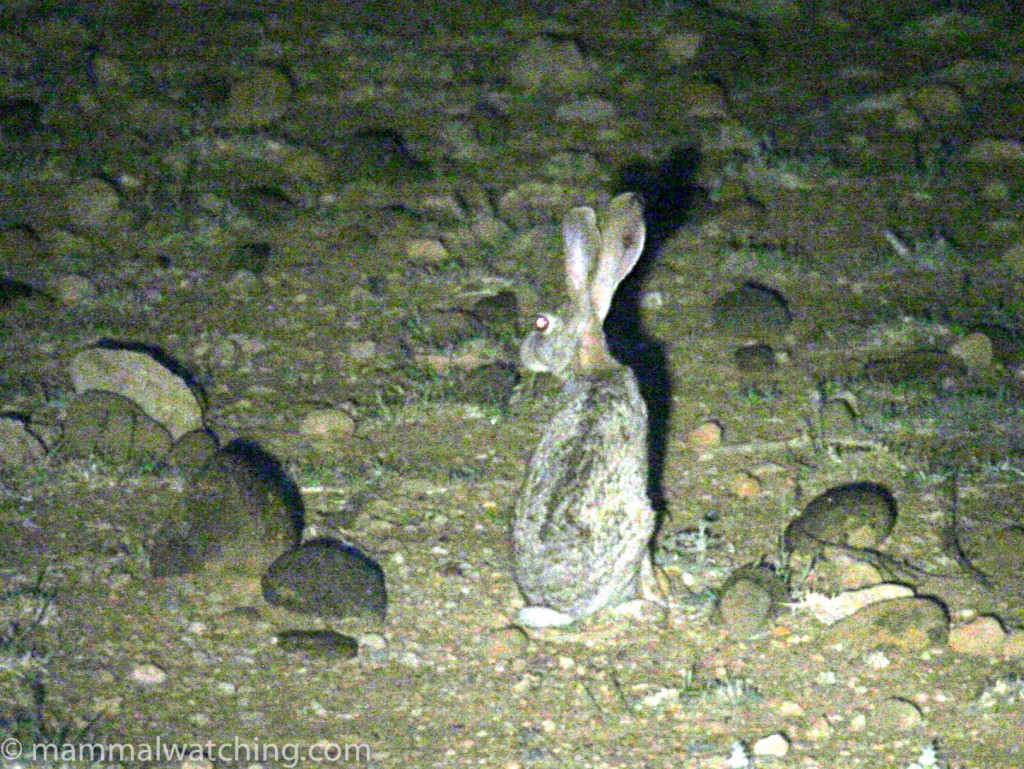
Abyssinian Hare, Lepus habessinicus
Three hours driving around the grassland that night found dozens of what I believe were Abyssinian Hares (the IUCN lists these as a recent split from Cape Hares and that they are found in Awash and other areas with little cover), Beisa Oryx and Dikdiks, a few Warthogs and Gazelles and a couple of Lesser Kudus. We saw three Black-backed Jackals and on the way back to the campsite there was a Common Genet wandering along the road.
Olive Baboons and a Grivet Monkey were raiding the campsite bins in the morning.
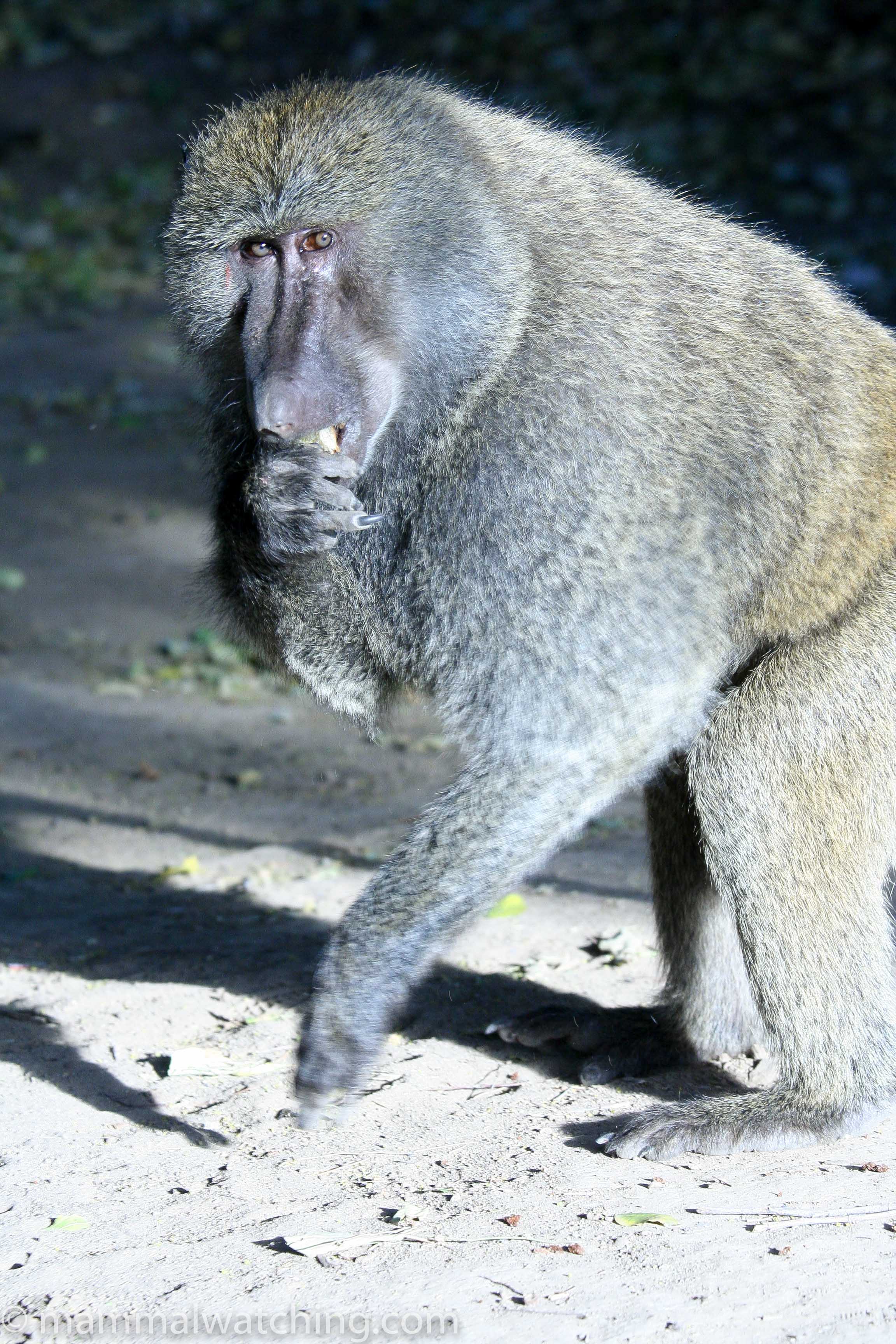
Olive Baboon, Papio anubis
At the park gates I met Solomon Mengistu, a Master’s student from Addis Ababa University who was researching into the park’s small mammals. He was good enough to delay his departure for a day to set some extra traps. Beauty!
The park’s population of Hamadryas Baboons moves around a bit but the area around Filhowa Hot Springs in the north of the park is one of the most reliable places to look for them. The Baboons have been studied for the past 15 years and there was an Australian guy working there when I went in mid-2007. He said that between 10am and noon was one of the best times to try to see the Baboons. They sometimes sleep at the springs but, even if they don’t sleep there, they often come in for a drink in the morning, though sometimes they don’t show up. We saw 20 or so on the cliffs overlooking the springs.
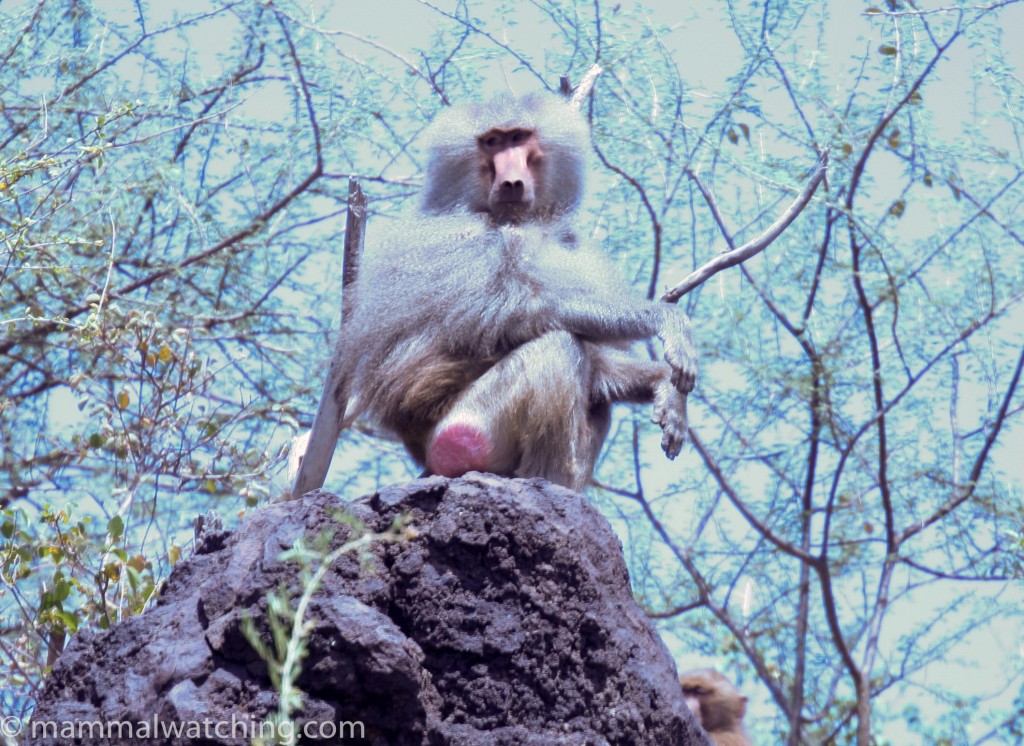
Hamadryas Baboon, Papio hamadryas
Back at the Filhowa camp we had coffee and I took a look at the Free-tailed Bats living in one of the houses. On the basis of size I guess these were a different species to those in Lake Langano.
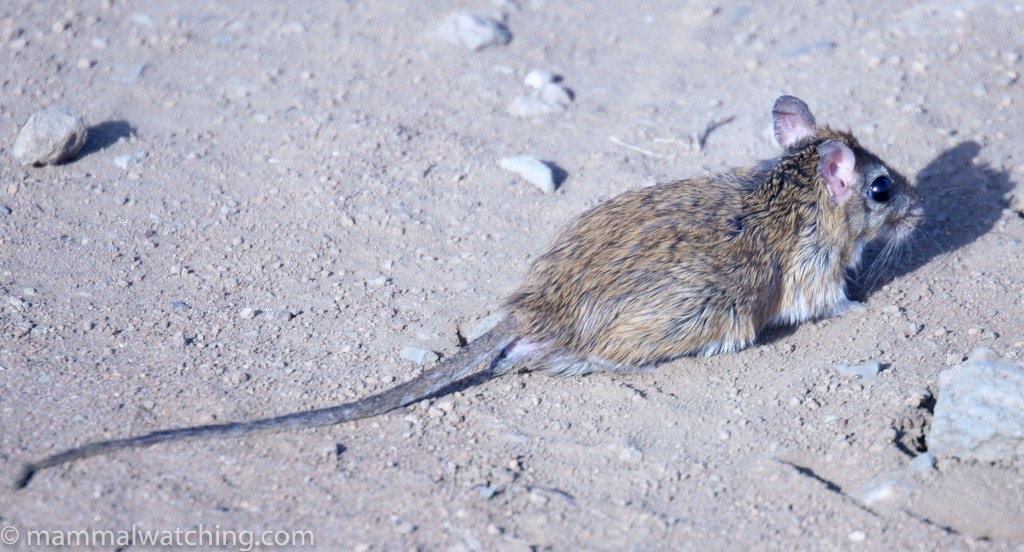
Fringe-tailed Gerbil, Tatera robusta
Back at Park HQ, Solomon had caught an African Grass Rat (Arvicanthus niloticus which is also referred to as A.dembeensi in Solomon’s thesis. This is the common diurnal species in the area (and very aggressive).
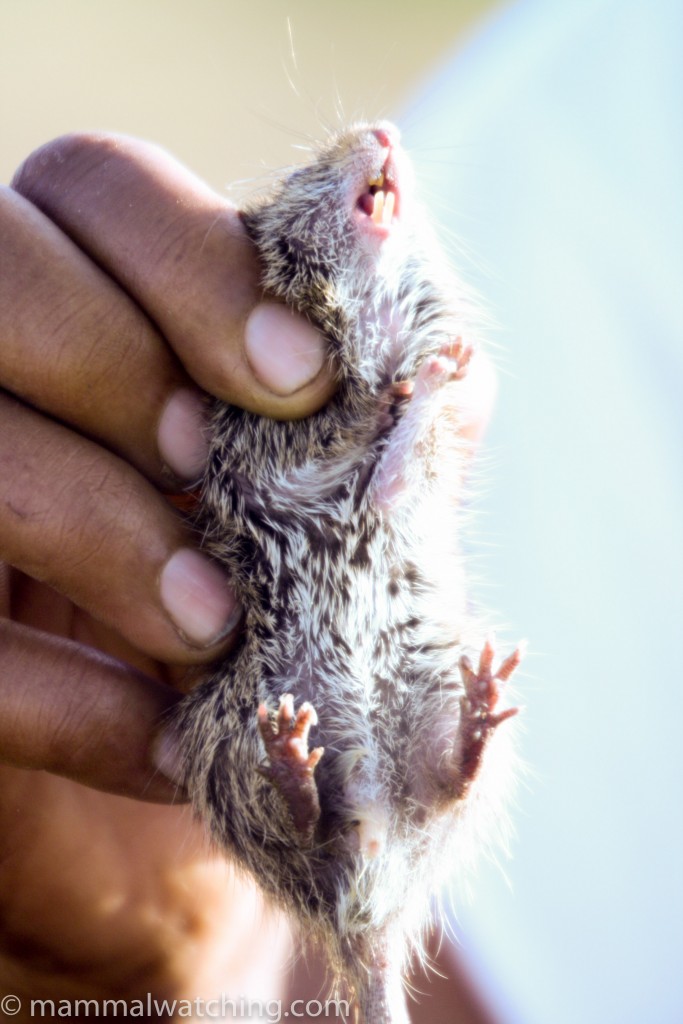
African Grass Rat, Arvicanthis niloticus
As per bloody usual for my life in the BA period (Before Aardvark, Nov 2007) I was trying to see an Aardvark. Hailu the scout, after phoning around, reckoned an area of scrub outside of the park and just north of the town of Mata Haraa could be a good place. I am not sure of the status of this land: I think it might have been a part of the Park at one point but had since been delisted. In any event there was a small ranger station based there and the country was open and ideal for spotlighting.
Bat-eared Foxes were everywhere – we must have seen 30 in a couple of hours. There was a largish Gerbil bouncing along the road near the ranger base (perhaps Tatera robusta), as well as a few Salt’s Dikdiks in some of the few patches of denser vegetation. Golden Wolves were plentiful (though there is also a theory that these are a different species Canis mengesi) and we had prolonged views of a Feline Genet on the way out (which responded well to me ‘squeaking’).
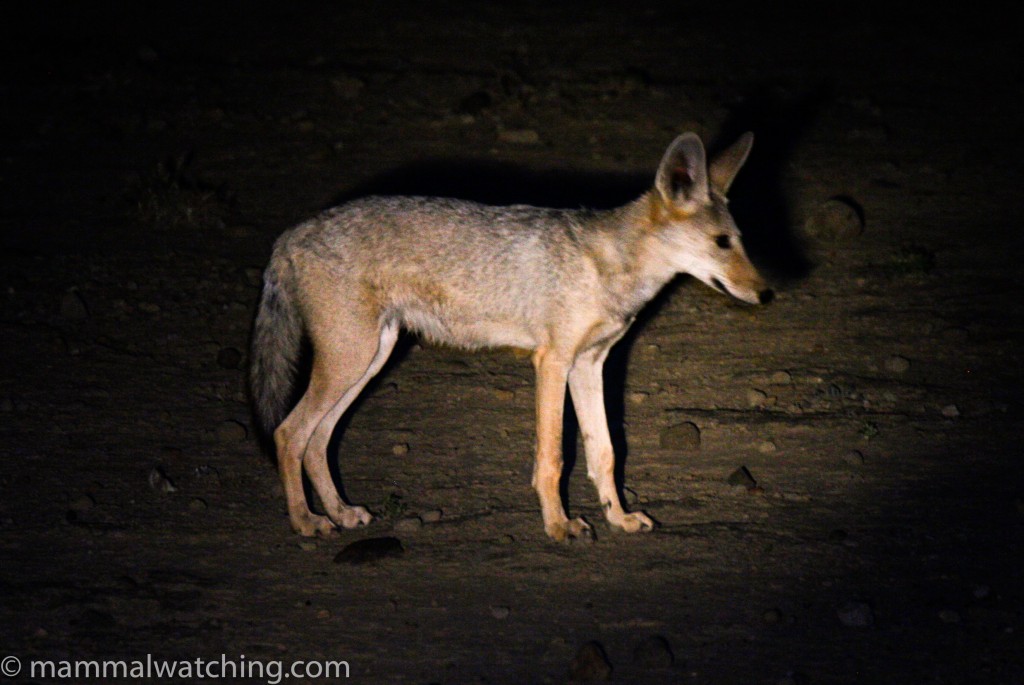
Golden Wolf, Canis anthus
By far the most interesting sighting was a fox moving through the very dry middle of the area. It wouldn’t stop when we approached but because the country was so open we could chase it in the car, getting to within 20 metres at times. Neither of the rangers with us had seen the species before which I am quite certain was a Rueppell’s Fox. It had a long and slim body, large ears and the final quarter of its tail was white. The trouble – so far as I can tell – is that Rueppell’s Foxes have not been recorded in Ethiopia before.
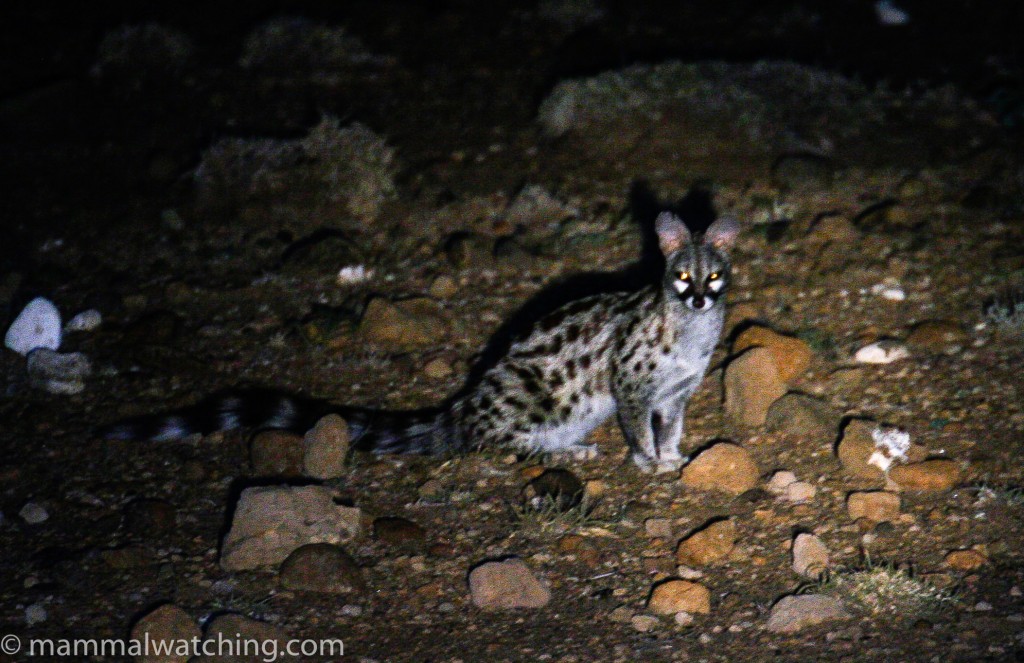
Feline Genet, Genetta felina
Back at the camp site and the ranger station there was a White-tailed Mongoose sniffing around and Hailu showed me a night roost of two species of bats in the car port cum tool shed. Some were Egyptian Tomb Bats.
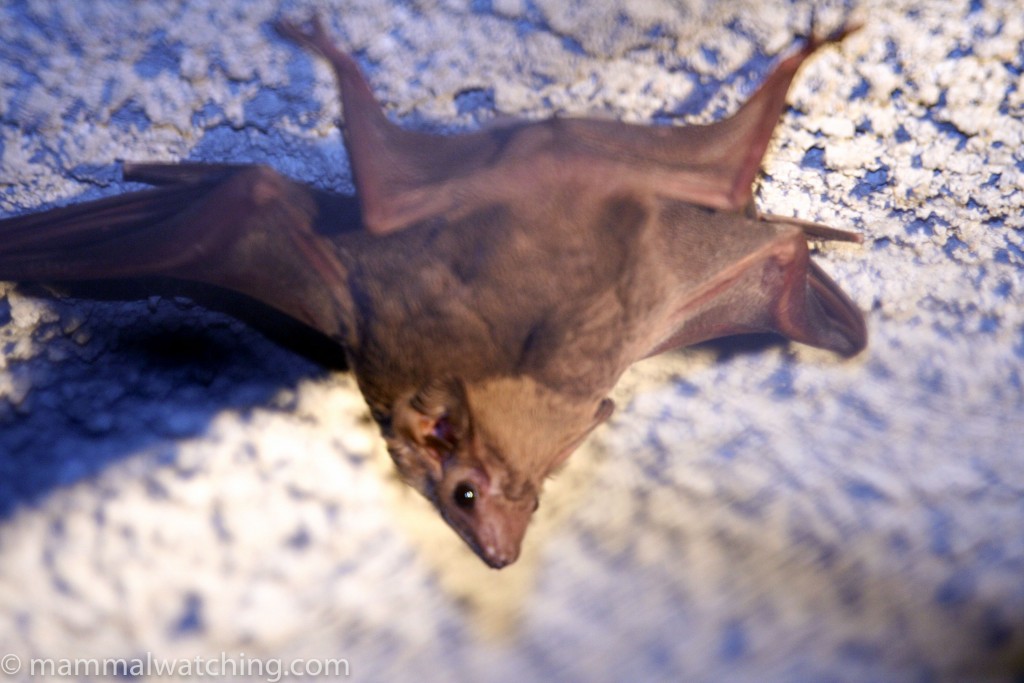
Egyptian Tomb Bat, Taphozous perforatus
The other was a distinctive looking roundleaf bat species with an orange-reddish head, pale inner ears and a simple noseleaf. The forearm was about 45mm long so I thinkthey were Sundevall’s Roundleaf Bat (Hipposideros caffer).
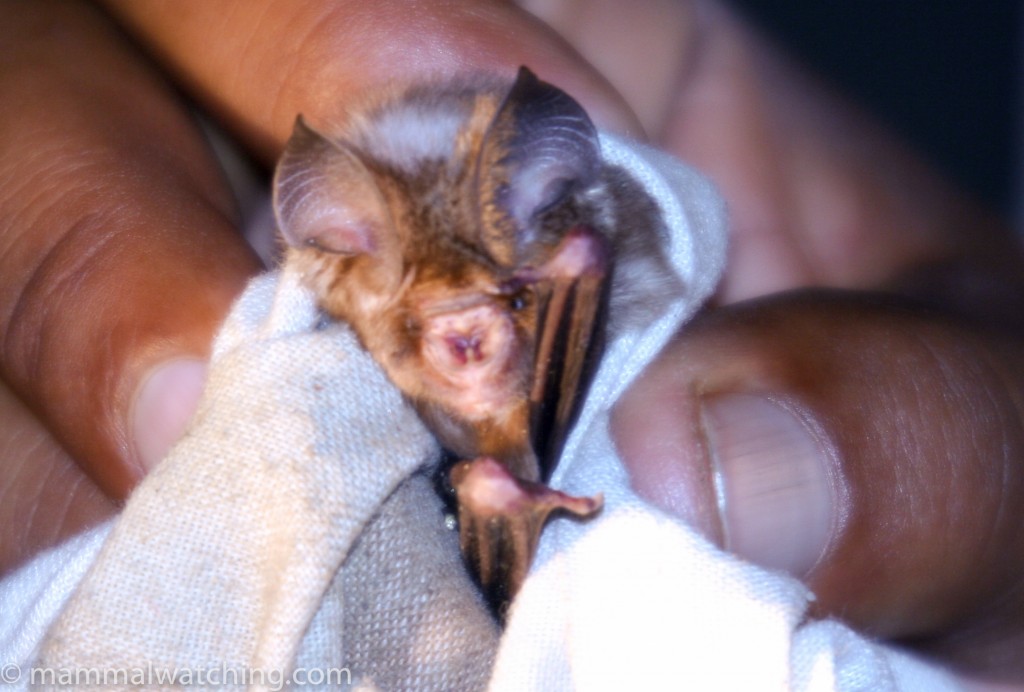
Sundevall’s Roundleaf Bat, Hipposideros caffer
The following morning I said goodbye to Solomon who had caught a pretty little Cairo Spiny Mouse – those spines really are spiny – and Fringe-tailed Gerbil, both of which Solomon identified later when he completed his thesis.
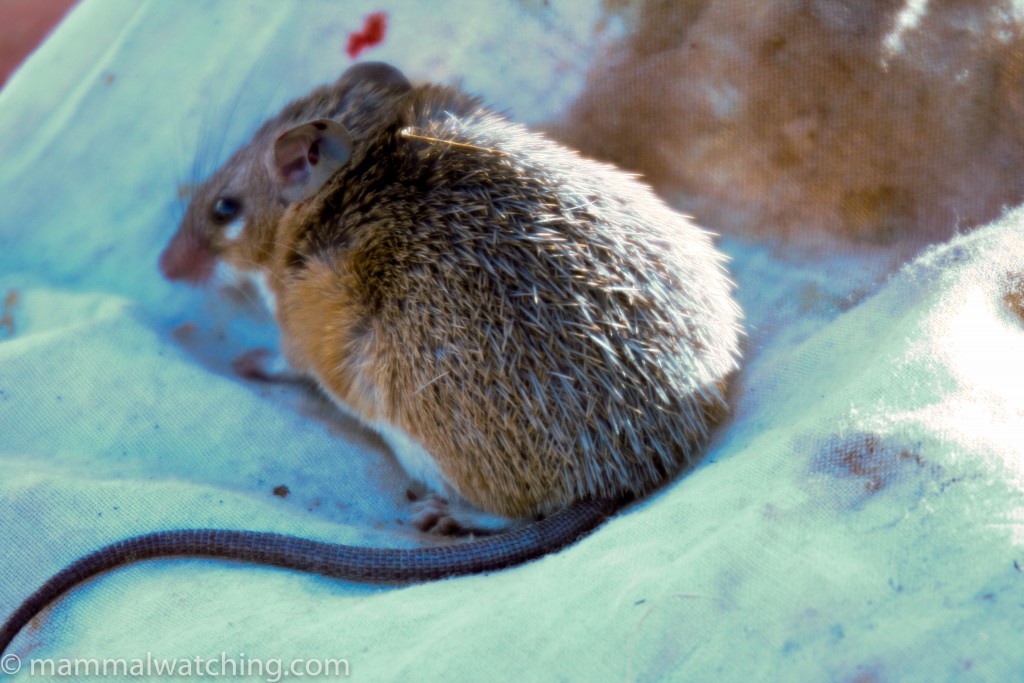
Cairo Spiny Mouse, Acomys cahirinus
I was told there aren’t any Gerenuks in Awash but they occur just 80kms to the east in a nature reserve. I was advised that there was a considerable likelihood of getting shot at if we visited. The Afar tribespeople living in the park were not friendly.
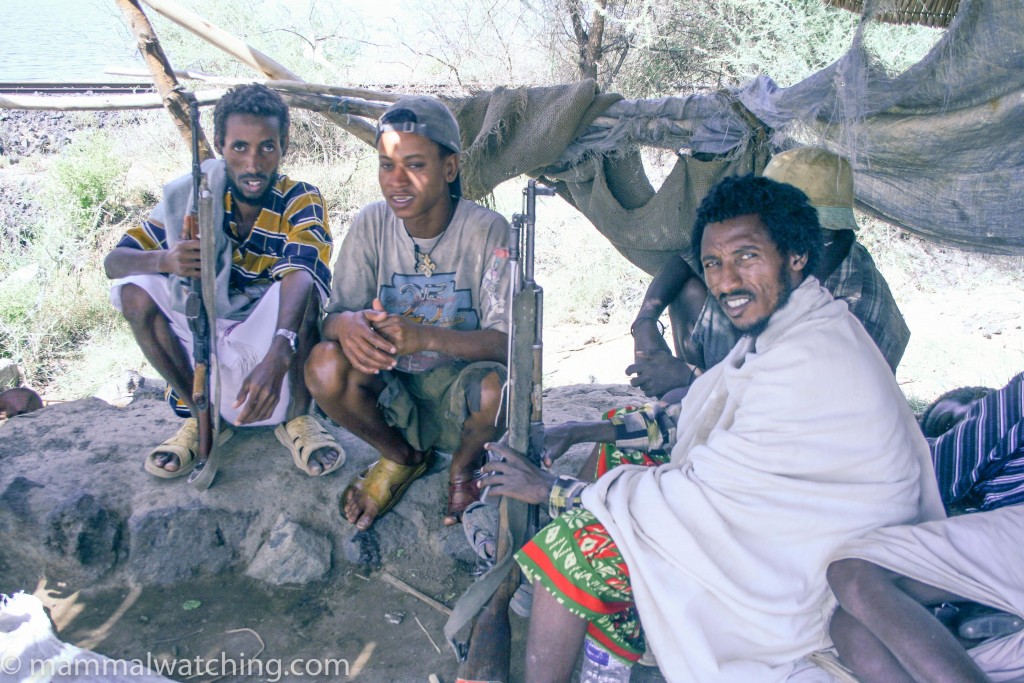
Don’t get your car washed here.
Beware of the local nomadic tribal people. For reasons I don’t fully understand, my driver decided to buy both charcoal and then a car wash from them. This was strange given his repeated warnings to me about the honesty of, and difficulties in doing business with, the nomads. In both cases they ripped him off over the price he’d agreed.
To add insult to injury his charcoal was confiscated by the police a few hundred metres up the road from there he bought it, and they used muddy sulphurous water for the car wash which did more harm than good. They also pointed their AK47s at me when I refused to pay them for a photo I had taken.
Other than that though, Ethiopia felt very safe and the local people were very friendly. Definitely somewhere to go back to.
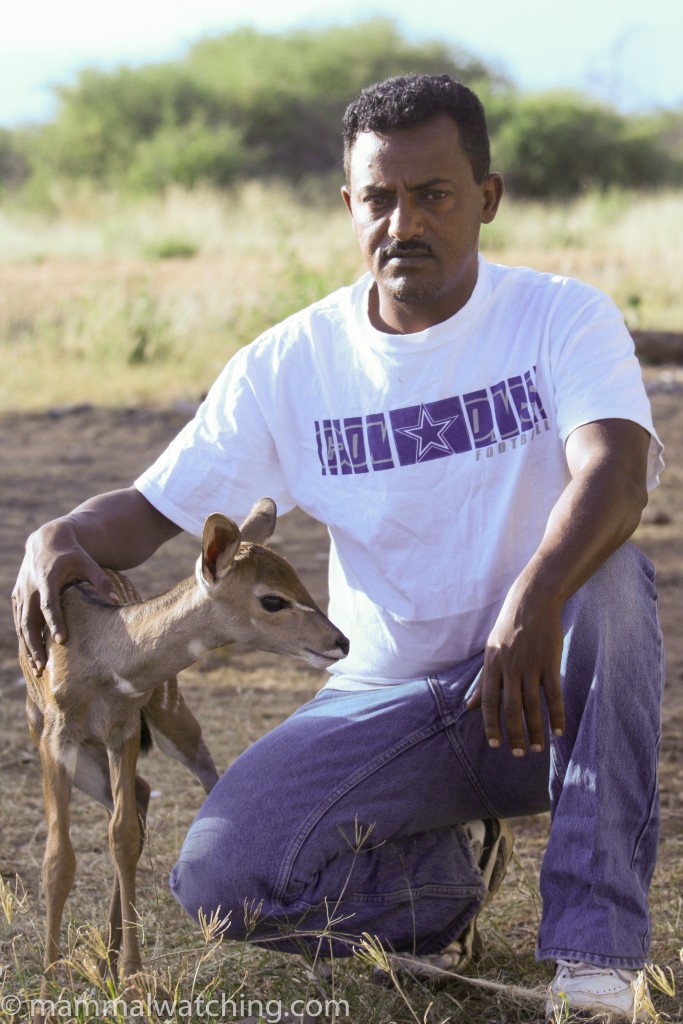
Trip List
Abyssinian Hare Lepus habessinicus
Ethiopian Highland Hare Lepus starcki
Black-clawed Brush-furred Rat Lophuromys melanonyx
Blick’s Grass Rat Arvicanthis blicki
African Grass Rat Arvicanthis niloticus
Cairo Spiny Mouse Acomys cahirinus
Fringe-tailed Gerbil Tatera robusta
Big-headed Mole-Rat Tachyoryctes macrocephalus
Feline Genet Genetta felina
Serval Felis serval
Common Slender Mongoose Herpestes sanguineus
White-tailed Mongoose Ichneumia albicauda
Rueppell’s Fox Vulpes rueppellii
Bat-eared Fox Otocyon megalotis
Golden Wolf Canis anthus
Black-backed Jackal Canis mesomelas
Ethiopian Wolf (Simien Fox) Canis simensis
Egyptian Tomb Bat Taphozous perforatus
Bushveld Horseshoe Bat Rhinolophus simulator
Sundevall’s Roundleaf Bat Hipposideros caffer
Little Free-tailed Bat Chaerephon pumila
Greater Long-fingered Bat Miniopterus inflatus
Guereza Colobus Colobus guereza
Gelada Baboon Theropithecus gelada
Olive Baboon Papio anubis
Hamadryas Baboon Papio hamadryas
Grivet Monkey Chlorocebus aethiops
Warthog Phacochoerus africanus
Hippopotamus Hippopotamus amphibius
Bright’s Gazelle Nanger notatus
Soemmerring’s Gazelle Gazella soemmerringii
Salt’s Dik-dik Madoqua saltiana
Klipspringer Oreotragus oreotragus
Oribi Ourebia ourebi
Mountain Nyala Tragelaphus buxtoni
Lesser Kudu Tragelaphus imberbis
Bushbuck Tragelaphus sylvaticus
Bohor Reedbuck Redunca redunca
Gemsbok (Beisa Oryx) Oryx gazella
Hartebeest Alcelaphus buselaphus
Bush Duiker Sylvicapra grimmia
Rock Hyrax Procavia capensis
Yellow-spotted Hyrax Heterohyrax brucei
44 species, with at least 1 bat and a shrew that I didn’t identify.


Leave a Reply
You must be logged in to post a comment.